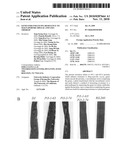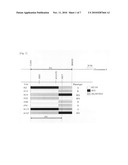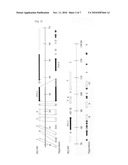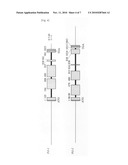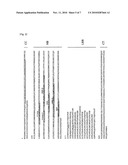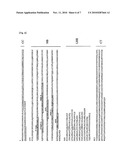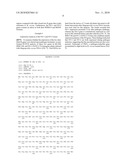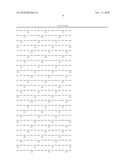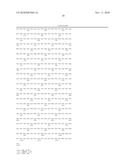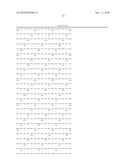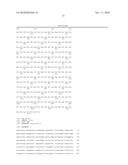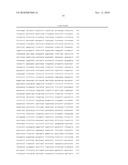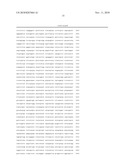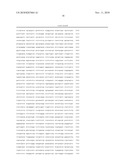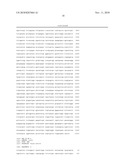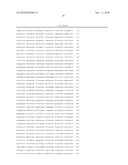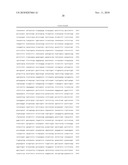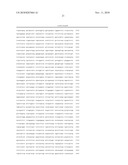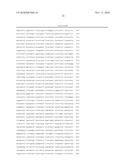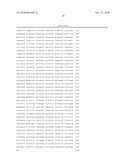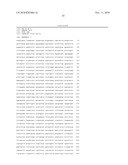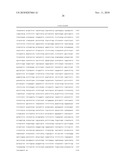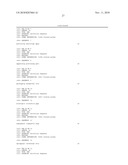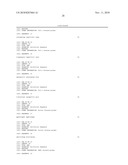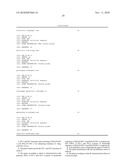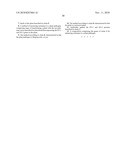Patent application title: Genes for enhancing resistance to magnaporthe oryzae and uses thereof
Inventors:
Jong Seong Jeon (Gyeonggi-Do, KR)
Pamela Ronald (Davis, CA, US)
Pamela Ronald (Davis, CA, US)
Sang Kyu Lee (Gyeonggi-Do, KR)
Min Young Song (Gyonggi-Do, KR)
Young Su Seo (Busan, KR)
Hye Kyung Kim (Gyeonggi-Do, KR)
Se Ho Ko (Gyeonggi-Do, KR)
Jung Pil Suh (Gyeonggi-Do, KR)
Gi Hwan Yi (Daegu, KR)
Gyn Heung An (Gyeongsangbuk-Do, KR)
Tae Ryoung Hahn (Gyeonggi-Do, KR)
Jae Hwan Roh (Gyeonggi-Do, KR)
Peijian Cao (Hangzhou, CN)
Assignees:
University-Industry Cooperation Group of Kyung Hee University
THE REGENTS OF THE UNIVERSITY OF CALIFORNIA
IPC8 Class: AA01H100FI
USPC Class:
800279
Class name: Multicellular living organisms and unmodified parts thereof and related processes method of introducing a polynucleotide molecule into or rearrangement of genetic material within a plant or plant part the polynucleotide confers pathogen or pest resistance
Publication date: 2010-11-11
Patent application number: 20100287664
Claims:
1. Pi5-1 and Pi5-2 proteins each consisting of SEQ ID NO: 1 and SEQ ID NO:
2 for enhancing resistance to Magnaporthe oryzae.
2. The genes which encode the Pi5-1 and Pi5-2 proteins of claim 1.
3. The genes according to claim 1, characterized in that genomic DNA of Pi5-1 and Pi5-2 consists of nucleotide sequences of SEQ ID NO: 3 and SEQ ID NO: 4, respectively, and cDNA of Pi5-1 and Pi5-2 consists of nucleotide sequences of SEQ ID NO: 5 and SEQ ID NO: 6, respectively.
4. A recombinant vector comprising the genes of claim 2.
5. The plant transformed with the recombinant vector of claim 4.
6. The plant according to claim 5, characterized in that it is a monocot plant.
7. Seeds of the plant described in claim 5.
8. A method of increasing resistance to a plant pathogen, comprising steps of transforming a plant with the recombinant vector described in claim 4 and then expressing the Pi5-1 and Pi5-2 genes in the plant.
9. The method according to claim 8, characterized in that the plant pathogen is Magnaporthe oryzae.
10. The method according to claim 8, characterized in that the plant is a monocot plant.
11. Antibodies against the Pi5-1 and Pi5-2 proteins described in claim 1.
12. A composition comprising the genes of claim 2 for enhancing resistance to a plant pathogen.
Description:
TECHNICAL FIELD
[0001]The present invention relates to genes for enhancing resistance to Magnaporthe oryzae and use thereof. More specifically, the present invention relates to Pi5-1 and Pi5-2 proteins which enhance resistance to Magnaporthe oryzae, genes which encode the proteins, a recombinant vector comprising the genes, a plant transformed with the recombinant vector and seeds thereof, a method of increasing resistance to a plant pathogen by expressing the genes in a plant, antibodies against the proteins, and a composition comprising the genes which are useful for enhancing resistance to a plant pathogen.
BACKGROUND ART
[0002]The innate immune response is critical to the survival of plants and animals. The response is mediated by the detection of pathogen-associated molecular patterns (PAMPs) (also referred to as microbe-associated molecular patterns) or avirulence (Avr) proteins by pathogen recognition receptors (PRRs; also called pattern recognition receptors or disease resistance proteins). In animals, a family of cytosolic PRRs that contain a nucleotide-binding oligomerization domain (NOD) mediates the apoptotic and inflammatory responses critical to protection from pathogen invasion. Plants also contain a set of intracellular PRR proteins, called NB-LRR (nucleotide binding-leucine rich repeat) R proteins, which are structurally similar to animal NOD proteins. These plant NB-LRR proteins are characterized by a tripartite domain architecture consisting of an N-terminal coiled-coil (CC) or Toll/interleukin-1 receptor (TIR) domain, a central NB domain, and a C-terminal LRR domain (Hammond-Kosack and Jones (1997) Annu. Rev. Plant Physiol. Plant Mol. Biol. 48: 575-607) and typically recognize pathogen-derived Avr proteins (also called effectors) (Van der Biezen and Jones (1998) Trends Biochem. Sci. 23: 454-456).
[0003]Rice blast is one of the most devastating diseases of rice and occurs in all areas of the world where rice is cultivated. More than 70 blast R genes that confer resistance to geographically different sets of the rice blast pathogen Magnaporthe oryzae isolates have been identified to date (Ballini et al. (2008) Mol. Plant. Microbe Interact. 21: 859-868). For example, Pib confers robust resistance to a majority of the Japanese Magnaporthe oryzae isolates (Wang et al. (1999) Plant J. 19: 55-64). In contrast, Pi37 confers only partial resistance to Japanese isolates but complete resistance to Chinese isolates of the same pathogen. Hence, the isolation of multiple R genes is required to fully understand the molecular basis of the resistance to rice blast. Such characterization of these genes will facilitate development of agronomically useful rice cultivars through markerassisted breeding or through transgenic approaches.
[0004]To date, a total of nine rice blast resistance genes have been cloned and characterized: Pib, Pita, Pi9, Pi2 and Piz-t, Pi-d2, Pi36, Pi37, and Pikm. With the exception of Pi-d2, a non-RD receptor-like kinase, these genes all encode NB-LRR type proteins. Distinct features of these cloned rice blast resistance genes have been observed. The Pib protein contains a duplicated NB region. Pita lacks a classic LRR but contains a leucine-rich domain (LRD) consisting of imperfect repeats of various lengths. A single amino acid difference at the Pita LRD was found to distinguish resistant from susceptible alleles. The allelic genes Pi2 and Piz-t show 8 amino acid differences within three consecutive LRRs, and these residues are responsible for resistance specificity. The Pi9 gene strongly resembles the Pi2 and Piz-t genes and is located within the same region on chromosome 6. The Pikm-mediated resistance requires two adjacent NB-LRR genes Pikm1-TS and Pikm2-TS. Among these cloned R genes, only Pita has been observed to interact with the corresponding Magnaporthe oryzae avirulence protein, AvrPita. Thus, defense signaling mediated by NB-LRR type proteins remains poorly characterized in rice.
[0005]It has been reported that Pi5 confers resistance to many Magnaporthe oryzae isolates collected from Korea and the Philippines (Wang et al. (1994) Genetics 136: 1421-1434). To gain a further understanding of the molecular basis of Pi5-mediated rice blast resistance, we used a map-based method to isolate the Pi5 genomic region. We previously mapped Pi5 to a 170-kb interval on the short arm of chromosome 9 in the RIL260 rice cultivar (Jeon et al. (2003) Molecular Genetics and Genomics 269: 280-289).
[0006]According to Korean Patent Registration No. 10-0764563, a gene for inducing resistance to a plant disease, a vector comprising the gene and a transformant obtained from the vector are described. Furthermore, according to Korean Patent Registration No. 10-0701302, plant disease-resistant ogpr 1 gene separated from wild rice, the amino acid sequence of the gene, and a transformant using the same are described. However, said gene is different from the gene of the present invention.
DISCLOSURE OF INVENTION
Technical Problem
[0007]The present invention is devised in view of the above-described needs. Specifically, in order to further narrow Pi5 resistant gene locus based on a new mapping population, two types of CC-NB-LRR genes, which are candidate genes for Pi5, were identified by sequence analysis of the genomic region having resistance. In addition, transgenic rice plants expressing one or both of said candidate genes were produced and their phenotypes resistant to Magnaporthe oryzae were characterized.
Technical Solution
[0008]In order to solve the problems described above, the present invention provides Pi5-1 and Pi5-2 proteins which enhance resistance to Magnaporthe oryzae.
[0009]Further, the present invention provides genes which encode the proteins.
[0010]Further, the present invention provides a recombinant vector comprising the genes.
[0011]Further, the present invention provides a plant transformed with the recombinant vector and seeds thereof.
[0012]Further, the present invention provides a method of increasing resistance to a plant pathogen by expressing the genes in a plant.
[0013]Further, the present invention provides antibodies against the proteins.
[0014]Still further, the present invention provides a composition comprising the genes which are useful for enhancing resistance to a plant pathogen.
ADVANTAGEOUS EFFECTS
[0015]According to the present invention, based on coordination between the Pi5-1 gene and the Pi5-2 gene, resistance to a plant pathogen, in particular Magnaporthe oryzae, can be enhanced.
BRIEF DESCRIPTION OF DRAWINGS
[0016]FIG. 1 represents chromosomal location of the Pi5 locus in the RIL260/IR50 population. (top) The 170-kb Pi5 resistance genomic region is shown between the markers C1454 and S04G03 in RIL260/CO39 and RIL260/M202. (bottom) A schematic diagram of the 8 rare recombinants in the Pi5 region identified in the RIL260/IR50 population. Breakage points are indicated between the relevant molecular markers. Open bars indicate the presumed RIL260 genome, black bars indicate the IR50 genome, and shaded bars indicate that the region is heterozygous between the two genomes. The bold arrow indicates the 130-kb minimal interval carrying the Pi5 locus, delimited by analysis of the mapping population. Resistance to Magnaporthe oryzae PO6-6 were determined in the F3 progeny of each line. R, resistant; S, susceptible; R/S, segregating line.
[0017]FIG. 2 represents genomic sequence comparison at the Pi5 loci in the RIL260 and Nipponbare cultivars. Predicted ORFs determined by RiceGAAS are shown for both genomes. NB-LRR genes, Pi5-1 alleles, and the Pi5-2 and Pi5-3 genes are indicated by black arrows. The N-terminal region of the Pi5-1Nipponbare allele that is absent in RIL260 is shown in green. Putative transposons and hypothetical genes are indicated by blue and gray arrows, respectively. Open arrows with numbers are predicted to encode the following proteins: 1, putative eukaryotic translation initiation factor; 2, putative GTP-binding protein; 3, putative tetrahydrofolate synthase; 4, putative aldose 1-epimerase; 5, putative histone H5; 6, putative cold-shock DEAD-box protein A; 7 and 10, ankyrin-like proteins; 8 and 9, HGWP-repeat containing proteins. The red dashed line indicates high similarity (>90%) between the RIL260 and Nipponbare ORFs. The chromosomal region that shows little or no homology is indicated by a thin line. The arrows indicate the direction of transcription. A gap in the DNA sequence in RIL260 is indicated by the dotted box.
[0018]FIG. 3 represents analysis of transgenic rice plants. (A) RT-PCR analysis of Pi5-1, Pi5-2 and Pi5-1/Pi5-2 F1 transgenic rice plants 2 days after inoculation with Magnaporthe oryzae PO6-6. The rice Actin1 gene was used as an internal control in these reactions. (B) Disease symptoms in Pi5-1, Pi5-2, and Pi5-1/Pi5-2 F1 transgenic plants 7 days after inoculation with Magnaporthe oryzae PO6-6. (C) Genomic DNA PCR analysis and disease reaction of F2 progeny derived from Pi5-1-63/Pi5-2-74 F1 transgenic plants in response to Magnaporthe oryzae PO6-6 infection. A resistant cultivar, RIL260 carrying Pi5, and a susceptible cultivar, Dongjin (DJ) lacking the Pi5 gene, were used as controls.
[0019]FIG. 4 represents genomic structure of the Pi5-1 and Pi5-2 genes and their gene products. Exons are indicated by light gray boxes and introns are indicated by bold lines. 5'- and 3'-untranslated regions (UTR) are indicated by dark gray boxes. ATG and TGA denote the translation initiation and stop codons, respectively and the numbers indicate the amino acid positions.
[0020]FIGS. 5 and 6 represents amino acid sequences of Pi5-1 protein and Pi5-2 protein, respectively. Both resistance proteins contain a coiled-coil (CC), nucleotide-binding site (NB), leucine-rich repeat (LRR), and C-terminal region (CT). Amino acids 31-67 of Pi5-1 and 26-87 of Pi5-2, shown in underlined italics, contain CC motifs. The conserved internal motifs characteristic of NB proteins, namely the P-loop, kinase-2, RNBS-B, GLPL, RNBS-D, and MHDV domains, are underlined and in bold. A conserved xLDL motif found in the LRR of many NB-LRR proteins is also underlined.
[0021]FIG. 7 represents RT-PCR analysis of the Pi5 genes and the PBZ1 gene in the RIL260 cultivar inoculated with Magnaporthe oryzae PO6-6. cDNAs prepared from the leaf tissue of RIL260 at 0, 4, 12, 24, 48 and 72 hr after pathogen inoculation were used in the experiment. The rice Actin1 gene was used as an internal control.
MODE FOR THE INVENTION
[0022]In order to achieve the purpose of the invention as described above, the present invention provides Pi5-1 and Pi5-2 proteins which can enhance resistance to Magnaporthe oryzae. In this regard, each of the Pi5-1 and Pi5-2 proteins cannot independently enhance resistance to Magnaporthe oryzae. Instead, only with coordination between the Pi5-1 and Pi5-2 proteins, enhancement of resistance to Magnaporthe oryzae can be obtained.
[0023]The scope of the Pi5-1 and Pi5-2 proteins of the present invention includes a protein having an amino acid sequence represented by SEQ ID NO: 1 or SEQ ID NO: 2 that is isolated from rice, and functional equivalents of said proteins. The term "functional equivalent" means that, as a result of addition, substitution or deletion of amino acid residues, it has an amino acid sequence with at least 70%, preferably at least 80%, more preferably at least 90%, still more preferably at least 95% homology with the amino acid sequence that is represented by SEQ ID NO: 1 or SEQ ID NO: 2, thus indicating a protein which has substantially the same physiological activity as the protein expressed by SEQ ID NO: 1 or SEQ ID NO: 2. The term "substantially the same physiological activity" indicates an activity of enhancing resistance of a plant to Magnaporthe oryzae.
[0024]The present invention further provides genes which encode said Pi5-1 and Pi5-2 proteins. Each of the Pi5-1 and Pi5-2 genes of the present invention may also comprise a coiled-coil (CC), a nucleotide-binding (NB) domain and a leucine-rich repeat (LRR) domain (see FIG. 5 and FIG. 6). The genes of the present invention include both genomic DNA and cDNA which encode Pi5-1 and Pi5-2 proteins. Specifically, cDNA sequence of Pi5-1 includes 5' and 3' non-translated regions, each comprising 70 by and 220 bp, respectively, and encodes 1,025 amino acids. cDNA sequence of Pi5-2 includes 5' and 3' non-translated regions, each comprising 73 by and 164 bp, respectively, and encodes 1,063 amino acids.
[0025]Preferably, each of the genomic DNAs of Pi5-1 and Pi5-2 of the present invention may comprise a nucleotide sequence that is described either by SEQ ID NO: 3 or by SEQ ID NO: 4. Further, each of the cDNAs of Pi5-1 and Pi5-2 of the present invention may comprise a nucleotide sequence that is described either by SEQ ID NO: 5 or by SEQ ID NO: 6. Variants of said nucleotide sequence are also within the scope of the present invention. Specifically, said gene may comprise a nucleotide sequence with at least 70%, preferably at least 80%, more preferably at least 90%, still more preferably at least 95% homology with the nucleotide sequences of SEQ ID NO: 3 to SEQ ID NO: 6. The "sequence homology %" for a certain polynucleotide is determined by comparing two nucleotide sequences that are optimally arranged with a region to be compared. In this regard, a part of the polynucleotide sequence in a region to be compared may comprise an addition or a deletion (i.e., a gap) compared to a reference sequence (without any addition or deletion) relative to the optimized arrangement of the two sequences.
[0026]Further, the present invention provides a recombinant vector comprising the Pi5-1 and Pi5-2 of the present invention.
[0027]The term "recombinant" indicates a cell which replicates a heterogeneous nucleotide or expresses said nucleotide, a peptide, a heterogeneous peptide, or a protein encoded by a heterogeneous nucleotide. Recombinant cell can express a gene or a gene fragment in a form of a sense or antisense, that are not found in natural state of cell. In addition, a recombinant cell can express a gene that is found in natural state, provided that said gene is modified and re-introduced into the cell by an artificial means.
[0028]The term "vector" is used herein to refer DNA fragment (s) and nucleotide molecules that are delivered to a cell. Vector can replicate DNA and be independently reproduced in a host cell. The terms "delivery system" and "vector" are often interchangeably used. The term "expression vector" means a recombinant DNA molecule comprising a desired coding sequence and other appropriate nucleotide sequences that are essential for the expression of the operatively-linked coding sequence in a specific host organism.
[0029]Preferably, the recombinant vector of the present invention is a recombinant plant expression vector.
[0030]A preferred example of plant expression vector is Ti-plasmid vector which can transfer a part of itself, i.e., so-called T-region, to a plant cell when the vector is present in an appropriate host such as Agrobacterium tumefaciens. Other types of Ti-plasmid vector (see EP 0 116 718 B 1) are currently used for transferring a hybrid gene to protoplasts that can produce a new plant by appropriately inserting hybrid DNA to a plant genome. Especially preferred form of Ti-plasmid vector is a so-called binary vector which has been disclosed in EP 0 120 516 B1 and U.S. Pat. No. 4,940,838. Other vector that can be used for introducing the DNA of the present invention to a host plant can be selected from a double-stranded plant virus (e.g., CaMV), a single-stranded plant virus, and a viral vector which can be originated from Gemini virus, etc., for example a non-complete plant viral vector. Use of said vector can be advantageous especially when a plant host cannot be appropriately transformed.
[0031]Expression vector would comprise at least one selective marker. Said selective marker is a nucleotide sequence having a property which allows a selection based on a common chemical method. Any kind of gene that can be used for the differentiation of transformed cells from non-transformed cell can be a selective marker. Example includes, a gene resistant to herbicide such as glyphosate and phosphintricin, and a gene resistant to antibiotics such as kanamycin, G418, bleomycin, hygromycin, and chloramphenicol, but not limited thereto.
[0032]For the plant expression vector according to one embodiment of the present invention, a promoter can be any of CaMV 35S, actin, ubiquitin, pEMU, MAS or histone promoter, but not limited thereto. The term "promoter" means a DNA molecule to which RNA polymerase binds in order to initiate its transcription and it corresponds to a DNA region upstream of a structural gene. The term "plant promoter" indicates a promoter which can initiate transcription in a plant cell. The term "constitutive promoter" indicates a promoter which is active in most of environmental conditions and development states or cell differentiation states. Since a transformant can be selected with various mechanisms at various stages, a constitutive promoter can be preferable for the present invention. Therefore, a possibility for choosing a constitutive promoter is not limited in the present invention.
[0033]For the above-described terminator, any conventional terminator can be used for the present invention. Example includes, nopaline synthase (NOS), rice α-amylase RAmy1 A terminator, phaseoline terminator, and a terminator for optopine gene of Agrobacterium tumefaciens, etc., but are not limited thereto. Regarding the necessity of terminator, it is generally known that such region can increase a reliability and an efficiency of transcription in plant cells. Therefore, the use of terminator is highly preferable in view of the contexts of the present invention.
[0034]Further, the present invention provides a plant that is transformed with the recombinant vector according to the present invention.
[0035]The plant according to the present invention is preferably a monocot plant including rice, barley, maize, wheat, rye, oat, turf grass, hay, millet, sugar cane, rye grass, orchard grass, and the like. Most preferably, it is rice.
[0036]Further, the present invention provides seeds of the above-described plants. Preferably, the seeds are rice seeds.
[0037]Further, the present invention provides a method of increasing resistance to a plant pathogen, comprising steps of transforming a plant with the recombinant vector of the present invention which includes the Pi5-1 and Pi5-2 genes and then expressing the Pi5-1 and Pi5-2 genes in the plant. Preferably, the pathogen is Magnaporthe oryzae. The above-described plant is preferably a monocot plant including rice, barley, maize, wheat, rye, oat, turf grass, hay, millet, sugar cane, rye grass, orchard grass, and the like. Most preferably, it is rice.
[0038]Plant transformation means any method by which DNA is delivered to a plant. Such transformation method does not necessarily have a period for regeneration and/or tissue culture. Transformation of plant species is now quite general not only for dicot plants but also for monocot plants. In principle, any transformation method can be used for introducing a hybrid DNA of the present invention to an appropriate progenitor cells. It can be appropriately selected from a calcium/polyethylene glycol method for protoplasts (Krens, F. A. et al., 1982, Nature 296, 72-74; Negrutiu I. et al., June 1987, Plant Mol. Biol. 8, 363-373), an electroporation method for protoplasts (Shillito R. D. et al., 1985 Bio/Technol. 3, 1099-1102), a microscopic injection method for plant components (Crossway A. et al., 1986, Mol. Gen. Genet. 202, 179-185), a particle bombardment method for various plants components (DNA or RNA-coated) (Klein T. M. et al., 1987, Nature 327, 70), or a (non-complete) viral infection method in Agrobacterium tumefaciens mediated gene transfer by plant invasion or transformation of fully ripened pollen or microspore (EP 0 301 316), etc. A method preferred in the present invention includes Agrobacterium mediated DNA transfer. In particular, so-called binary vector technique as disclosed in EP A 120 516 and U.S. Pat. No. 4,940,838 can be preferably adopted for the present invention.
[0039]The term "plant cell" that is used for the plant transformation according to the present invention can be any plant cell. The plant cell can be a cultured cell, a cultured tissue, a cultured organ, or a whole plant, preferably a cultured cell, a cultured tissue or a cultured organ, and more preferably any form of a cultured cell. Preferably, the plant is rice.
[0040]The term "plant tissue" includes either differentiated or undifferentiated plant tissue, including root, stem, leaf, pollen, seed, cancerous tissue and cells having various shape that are used for culture, i.e., single cell, protoplast, bud and callus tissue, but not limited thereto. Plant tissue can be in planta or in a state of organ culture, tissue culture or cell culture.
[0041]Further, the present invention provides antibodies against the Pi5-1 and Pi5-2 proteins of the present invention. According to the present invention, the term "antibody" includes a monoclonal antibody, a multi-specific antibody, a human antibody, a humanized antibody, a camelised antibody, a chimera antibody, a single-chain Fvs (scFv), a single-chain antibody, a single-domain antibody, a Fab fragment, a F(ab) fragment, a disulfide-bonding Fvs (sdFv), an anti-idiotype (anti-Id) antibody, or a fragment which binds to any of the above-described epitopes. In particular, an immunoglobulin molecule and an immunologically-active fragment of an immunoglobulin molecule, i.e., a molecule which comprises an antigen-binding region, are included in the antibody of the present invention. An immunoglobulin molecule can be any kind including IgG, IgE, IgM, IgD, IgA, and IgY or any class including IgG1, IgG2, IgG3, IgG4, IgA1, and IgA2 or their subclass.
[0042]The antibody of the present invention can be prepared according to a general method which comprises steps of cloning the genes of the present invention in an expression vector by following a typical procedure to obtain a protein and preparing the antibody from the protein. Herein, a partial peptide which can be generated from the protein is also included. As for a partial peptide of the present invention, it comprises at least seven amino acids, preferably at least nine amino acids, and more preferably at least twelve amino acids. Type of the antibody of the present invention is not specifically limited. A monoclonal antibody, a polyclonal antibody and a part of such antibodies having an antigen-binding property are all included in the antibody of the present invention. All kinds of immunoglobulin antibody are also included. Furthermore, a special antibody such as a humanized antibody and the like is also included in the antibody of the present invention.
[0043]Still further, the present invention provides a composition comprising the Pi5-1 and Pi5-2 genes for enhancing resistance to a plant pathogen. Since the Pi5-1 and Pi5-2 proteins of the present invention enhance resistance to a plant pathogen based on coordination between them, the composition comprising the Pi5-1 and Pi5-2 genes can be used for enhancing resistance to a plant pathogen. Preferably, the plant pathogen is Magnaporthe oryzae.
[0044]The present invention will now be described in greater detail with reference to the following examples. However, it is only to specifically exemplify the present invention and in no case the scope of the present invention is limited by these examples.
EXAMPLES
Plant Materials
[0045]The RIL260 rice cultivar carrying the Pi5 allele and a rice blast-susceptible cultivar, IR50, were used as the parental lines in this study. The RIL260 and IR50 cultivars were crossed to generate a mapping population for genetic linkage analysis. Self-pollinated seeds (F2) of the RIL260/IR50 F1 individuals were collected to obtain a sufficiently large mapping population. A japonica rice cultivar, Dongjin, was used as the susceptible control in the Magnaporthe oryzae inoculation and rice transformation experiments. RIL260 and the monogenic rice line IRBL5-M carrying Pi5 were used as the resistant control cultivars in the Magnaporthe oryzae inoculation experiments. An additional 8 monogenic rice lines, IRBL1-F5, IRBL9-W, IRBLb-B, IRBLta-K1, IRBLz-Fu, IRBLks-F5, IRBLkm-Ts, and IRBLsh-S, and the susceptible background cultivar of these monogenic lines, Lijiangxintuanheigu (LTH) were also used in the inoculation experiments to determine the virulence pattern of Magnaporthe oryzae isolates. Rice seedlings were grown in a greenhouse at 30° C. during the day and at 20° C. at night in a light/dark cycle of 14/10 hr.
[0046]Pathogen Inoculation and Disease Evaluation
[0047]Magnaporthe oryzae PO6-6, a Philippine isolate, which is incompatible with the Pi5 resistance locus, has been commonly used to detect this locus. To analyze blast resistance in Pi5 transgenic rice plants, an additional 5 different Korean Magnaporthe oryzae isolates, KJ105a, KJ107, KJ401, KI215, and R01-1, were used. All inoculations and disease evaluations were conducted in the greenhouse facilities at Kyung Hee University using a method that was slightly modified from Liu et al. (2002, Mol. Genet. Genomics 267: 472-480). Three week-old plants of the F3 progeny of each of the identified recombinant lines and transgenic plants were used in the inoculation experiments. Magnaporthe oryzae was grown on oatmeal agar medium for 2 weeks at 24° C. in the dark. Conidia were induced 4 days prior to collection by scratching the plate surface with a sterilized loop. The inoculated plants were placed in sealed containers to maintain humidity at 24° C. in darkness for 24 hr, and then transferred to a growth chamber at 24° C. and 80% humidity under a 14/10-hr (light/dark) photoperiod. Disease evaluation was carried out 7 days after inoculation.
[0048]Genotypic Analysis of Progeny from the RIL260/IR50 Mapping Population
[0049]Cleaved amplified polymorphic sequence (CAPS) markers for C1454 and JJ817 and a sequence characterized amplified region (SCAR) marker JJ803 (corresponding to the previously reported dominant marker JJ80-T3) were used for the analysis of the RIL260/IR50 segregating progeny (Table 1). The dominant markers JJ113-T3 and S04G03 were additionally utilized as needed.
TABLE-US-00001 TABLE 1 PCR primers used in this study Marker Forward primer Reverse primer or gene (5'-3') (5'-3') C1454 GTATTACCTGAAATCCTA AGGAACTACGGTATTACA GTGGTG AGGATC (SEQ ID NO: 7) (SEQ ID NO: 8) JJ817 GATATGGTTGAAAAGCTA ATCATTGTCCTTCATATT ATCTCA CAGAGT (SEQ ID NO: 9) (SEQ ID NO: 10) JJ803 AAGTGAGCATCCAGTGCC AGCCGGTGCTCATAACAC TAATGA GTATTA (SEQ ID NO: 11) (SEQ ID NO: 12) Pi5-1 TACAAGTTGGCAGCTTTA TCAGAAGCACTGGATCTT TCTGAG TCTGCA (SEQ ID NO: 13) (SEQ ID NO: 14) Pi5-2 AGTGAACTCCAAACATGT TCATACCTGTTGCGGTTT GAACAC CTGCCT (SEQ ID NO: 15) (SEQ ID NO: 16) Actin1 GGAACTGGATAGGTCAAG AGTCTCATGGATACCCGC GC AG (SEQ ID NO: 17) (SEQ ID NO: 18) PBZ1 ACCATCTACACCATGAAG GTATTCCTCTTCATCTTA CTTAAC GGCGTA (SEQ ID NO: 19) (SEQ ID NO: 20)
[0050]Genomic DNA was isolated from young leaves of rice plants using a simple miniprep method (Chen and Ronald (1999) Plant Mol. Biol. Rep. 17: 53-57). PCR analysis was performed in a final volume of 30 μl (100 pM of each primer, 200 μM each of dNTPs, 10 mM Tris-HCl pH 9.0, 2 mM MgCl2, 50 mM KCl, 0.1% Triton X-100 and 0.5 U Taq polymerase) using 50 ng of genomic DNA as template. PCR products for the CAPS markers C1454 and JJ817 were subsequently digested with Mlu I and AseI, respectively, and then size-fractionated on agarose gels.
[0051]DNA Sequencing and Gene Prediction
[0052]RIL260 Binary BAC (BIBAC) clones spanning the Pi5 locus were selected for DNA sequencing analysis. Plasmids purified by a minipreparation were partially digested with Sau3AI and separated by agarose gel electrophoresis. The 0.5-3.0 kb genomic DNA fragments were isolated using a commercial kit (Gel Extraction Kit, Qiagen), subcloned into the BamHI site of pBluescriptII SK(-) (Clontech), and then transformed into E. coli DH10B by electroporation. For DNA sequencing of each BIBAC clone with a 25-kb average insert size, about 60 clones were selected and sequenced in one or both directions using the T3 and T7 primers.
[0053]Similarity searches against the NCBI database (http://www.ncbi.nlm.nih.gov/) were performed using BLAST (Basic Local Alignment Search Tool). To predict proteincoding gene regions, the Rice Genome Automated Annotation System (RiceGAAS) was utilized (http://RiceGAAS.dna.affrc.go.jp/).
[0054]Vector Construction for Genetic Complementation Experiments
[0055]Genomic DNA regions for Pi5-1 and Pi5-2 were reconstituted by subcloning from BIBAC clones (Jeon et al. (2003) Mol. Genet. Genomics 269: 280-289). To construct a clone carrying the entire Pi5-1 coding region, a 6.6-kb BamHI-SacI fragment of the JJ80 vector that includes the 0.5-kb predicted promoter was subcloned into the binary vector pC1300intC (GenBank accession no. AF294978). The resulting plasmid JJ104 was digested with BamHI and BstEII and fused to 7.3-kb HindIII-BstEII insert of JJ106 to construct JJ105 with a 5.2-kb promoter region. The 0.5-kb SacI-XhoI fragment was amplified by PCR using primers 5'-GTCCAAAGAGAAATGCGACAACAC-3' (SEQ ID NO: 21) and 5'-CGCTCGAGGTGGCATTTCATCCAATAGGCAAC-3' (SEQ ID NO: 22). The resulting product was inserted into the JJ105 to extend the terminator region, yielding the JJ204 construct carrying the 11,516-bp Pi5-1 genomic region.
[0056]The Pi5-2 gene was constructed by the multiple ligation of the following four fragments: a 4.2-kb EcoRI-BglII DNA fragment of JJ113, a 200-bp BglII-ClaI PCR product amplified using the primers 5'-GGATGATGTGATCTGCAGAGAAAC-3' (SEQ ID NO: 23) and 5'-CAGCCTCACTGAAATTGCGAAGCA-3' (SEQ ID NO: 24), a 4.2-kb ClaI-XbaI DNA fragment of JJ120, and an EcoRI-XbaI digested pC1300intC vector fragment. In the resulting construct JJ117, the promoter region was extended by cloning the 3.7-kb NsiI-EcoRI fragment of JJ120. Finally, by inserting a 0.9 kb-extended terminator sequence into the Eco065I site of the JJ142 plasmid, the 13,250-bp entire genomic sequence of Pi5-2 in JJ212 was constructed. The cloned genomic sequences in JJ204 and JJ212 were confirmed by DNA sequencing.
[0057]Production of Transgenic Rice Plants
[0058]Genomic clones for Pi5-1 and Pi5-2 were transformed into Agrobacterium tumefaciens EHA105 or LBA4404 by electroporation and introduced into the susceptible rice cultivar Dongjin via Agrobacterium mediation according to an established procedure (Jeon et al. (2000) Plant J. 22: 561-570). The transgenic plants (T0) were self-pollinated and T1 seeds were collected. Homozygous Pi5-1 (Pi5-1-63) and Pi5-2 (Pi5-2-74) transgenic lines were then selected from T2 progeny resulting from selfpollination of the T1 lines based on the segregation patterns of the transgenes. F1 plants carrying both Pi5-1 and Pi5-2 were produced from a cross between Pi5-1-63 and Pi5-2-74 lines, and self-pollinated to produce F2 plants.
[0059]Isolation of Pi5-1 and Pi5-2 cDNAs
[0060]Two preparations of total RNA were prepared from rice leaves collected at 24 and 48 hr after inoculation with Magnaporthe oryzae PO6-6 using Trizol reagent (Invitrogen). Purified mRNAs were obtained using the PolyATtract mRNA isolation system (Promega) from each set of total RNA and mixed in a 1:1 ratio for cDNA synthesis. cDNAs larger than 0.5 kb were selected by size fractionation via gel filtration, and a cDNA library was constructed with the Uni-ZAP XR vector (Stratagene). This library was then screened via colony blot hybridizations using probes corresponding to the Pi5-1 and Pi5-2 coding regions, a 570-bp HindIII-KpnI fragment of JJ204 and a 589-bp EcoRV-SpeI fragment of JJ212, respectively. Isolated cDNA clones were analyzed by DNA sequencing.
[0061]RT-PCR Analysis
[0062]To examine the changes in transcript accumulation in response to pathogen treatment, leaves from each of 10 RIL260, IRBL5-M, and transgenic rice plants inoculated with Magnaporthe oryzae PO6-6 were collected at different time periods for RT-PCR analysis. Total RNA was prepared using Trizol reagent and reversetranscribed with an oligo-dT primer and a First Strand cDNA Synthesis Kit (Roche). First-strand cDNA was used in PCR reactions with gene-specific primers. Primers for the rice Actin1 gene and the pathogenesis-related probenazole-inducible (PBZ1) gene were used as internal controls (Table 1). PCR conditions were as follows: 94° C. for 5 min followed by 28-35 cycles of 94° C., 1 min; 56° C., 1 min; and 72° C., 1 min, and a final extension at 72° C. for 5 min. Three independent amplifications were performed for each primer set.
Example 1
Genetic Characterization of a 130-kb Chromosomal Region Carrying Pi5
[0063]Previously, the Pi5 resistance gene was delimited to a 170-kb interval between the two flanking markers S04G03 and C1454 on rice chromosome 9. This finding was the result of our previous analysis of two populations generated by crosses between RIL260 carrying Pi5 and a susceptible cultivar CO39, and between RIL260 and another susceptible cultivar M202 (Jeon et al. (2003) Mol. Genet. Genomics 269: 280-289). To further delineate the Pi5 gene, in the present study, we generated a third mapping population derived from a cross between RIL260 and another susceptible cultivar IR50. Through PCR screening we found that among the susceptible cultivars tested, only IR50 contained the dominant marker JJ817, which was also found in the resistant cultivar RIL260 (data not shown). In contrast, we were not able to amplify a PCR product for JJ817 in other susceptible cultivars including CO39 and M202. We selected IR50 as a mapping parent based on the similarity between the genomic regions for RIL260 and IR50 which we speculated could facilitate recombination in the interval.
[0064]To identify rare recombinants within the 170-kb Pi5 locus, a prescreening strategy using the CAPS markers JJ817 and C1454 and a SCAR marker JJ803 was employed in our current analysis of the RIL260/IR50F2 population. Of the 2,014 F2 individuals analyzed, we identified 8 recombinants between JJ817 and JJ803, but none between JJ803 and C1454 (FIG. 1). Using the dominant markers JJ113-T3 and S04G03, we subsequently determined the breakage points of the 8 recombinants we isolated in their progeny (F3) plants, which enabled us to distinguish homozygous from heterozygous genotypes. In total, all 8 lines were found to harbor recombination events between JJ113-T3 and JJ817.
[0065]The disease phenotypes resulting from Magnaporthe oryzae PO6-6 infection of these 8 identified lines were then determined in the F3 progeny in each case. These experiments further delimited the Pi5 gene to a 130-kb interval between the markers JJ817 and C1454 (FIG. 1). Our previous and current results indicated that both the JJ803 and JJ113-T3 markers cosegregate with Pi5-mediated resistance (FIG. 1). We were unable to further fine-map the R gene at the Pi5 locus.
Example 2
Genomic Sequence Analysis of the 130-kb Chromosomal Region Containing the Pi5 Locus
[0066]To identify candidate R genes in the Pi5 locus, 7 BIBAC clones, JJ80, JJ98, JJ106, JJ110, JJ113, JJ120, and JJ123, which covered the 130-kb Pi5 region were selected and sequenced. BLAST searches using these sequences against the public databases and also gene annotation analysis using the RiceGAAS program predicted a total of 18 open reading frames (ORFs) at the Pi5 locus in the RIL260 cultivar: 7 hypothetical proteins, 2 NB-LRR proteins, 2 putative transposon proteins, a putative eukaryotic translation initiation factor, a putative GTP-binding protein, a putative tetrahydrofolate synthase, a putative aldose 1-epimerase, a putative histone H5, a putative cold-shock DEAD-box protein A, and an ankyrin-like protein (FIG. 2). From this genomic sequence analysis, two Pi5 candidate genes that showed homology with NB-LRR resistance genes were identified in RIL260 and designated Pi5-1 and Pi5-2.
[0067]The region of approximately 90 kb, from JJ803 to JJ817, of the 130-kb RIL260 Pi5 interval was compared with the corresponding region of the japonica genome represented by the sequenced cultivar Nipponbare (International Rice Genome Sequencing Project 2005; FIG. 2). The resulting sequence analysis showed that the NipponbarePi5 interval contains two NB-LRR genes, Os09g15840 (a Pi5-1 allelic gene) and a gene which was not identified in RIL260, Os09g15850, denoted Pi5-3. In contrast, Nipponbare lacks the corresponding allele of Pi5-2. Notably, the 5 upstream sequences of the Pi5-1 allelic genes of RIL260 and Nipponbare were very different, indicating an extreme sequence divergence within the regulatory sequences of these alleles. In addition, we did not observe significant sequence similarity in any other part of the 90-kb Pi5 intervals in RIL260 and Nipponbare (FIG. 2). These results suggest that the Pi5 resistance locus has significantly diverged between these resistant and susceptible rice cultivars.
[0068]We did not compare the Pi5 resistance locus with that of the publicly sequenced indica rice cultivar 93-11 due to a large gap at this locus. In an inoculation experiment, we found that both Nipponbare and 93-11 were susceptible to Magnaporthe oryzae PO6-6 (data not shown), indicating neither carries the Pi5 resistance gene.
Example 3
Characterization of Transgenic Rice Plants Expressing Pi5 Candidate Genes
[0069]To determine which one of the two candidate genes, Pi5-1 and Pi5-2, is responsible for the Pi5-mediated resistance to M. oryzae, we used the genomic clones JJ204 and JJ212 carrying Pi5-1 and Pi5-2, respectively, under the control of their native promoters to transform the susceptible japonica rice cultivar Dongjin using Agrobacterium-mediated transformation. RT-PCR analysis of the resulting transgenic lines revealed that 13 of 15 Pi5-1 and 12 of 13 Pi5-2 independently transformed lines expressed their transgenes upon Magnaporthe oryzae PO6-6 inoculation (FIG. 3A). The primary transgenic lines (To) carrying either Pi5-1 or Pi5-2 were inoculated with Magnaporthe oryzae PO6-6. Surprisingly, however, none of the 13 Pi5-1 or the 12 Pi5-2 transgenic plants showed resistance to Magnaporthe oryzae isolate PO6-6 (FIG. 3B). To confirm these results, we inoculated T1 progeny from these To lines and found that all progeny were susceptible to the Magnaporthe oryzae isolate to the same extent as the wild-type control Dongjin cultivar. This indicates that neither Pi5-1 nor Pi5-2 alone confers resistance to Magnaporthe oryzae PO6-6.
Example 4
Characterization of Transgenic Rice Plants Expressing Both Pi5-1 and Pi5-2
[0070]Because recent reports (Sinapidou et al. (2004) Plant J. 38: 898-909) have demonstrated that the presence of two R genes is required for resistance to pathogen infection, we decided to test plants expressing both candidate genes for blast resistance. We therefore generated transgenic plants carrying both Pi5-1 and Pi5-2 by crossing a highly susceptible homozygous Pi5-I line #63 (Pi5-1-63) with the highly susceptible homozygous Pi5-2 line #74 (Pi5-2-74). Gene expression analysis revealed that the F1 plants resulting from the cross expressed both the Pi5-1 and Pi5-2 genes upon Magnaporthe oryzae PO6-6 inoculation (FIG. 3A). Strikingly, the 23 of Pi5-1-63/Pi5-2-74 F1 plants tested all displayed complete resistance to Magnaporthe oryzae PO6-6. Transgenic lines carrying either Pi5-1 or Pi5-2 were susceptible as previously determined (FIG. 3B).
[0071]To confirm this finding, we inoculated the F2 progeny plants from the Pi5-1-63/Pi5-2-74 F1 lines with the Magnaporthe oryzae isolate PO6-6. Of the 72 F2 progeny tested, 37 of these carried both transgenes and conferred resistance to Magnaporthe oryzae PO6-6. In contrast F2 progeny lacking both Pi5-1 and Pi5-2 were susceptible (FIG. 3C). RT-PCR analysis demonstrated that the Pi5-1-63/Pi5-2-74 lines expressed their transgenes at levels that were similar to RIL260 before and after Magnaporthe oryzae PO6-6 inoculation. To test if Pi5-1 and Pi5-2 are required for resistance to other Magnaporthe oryzae isolates, we inoculated the transgenic plants with four additional isolates incompatible with Pi5. These isolates displayed distinct virulence patterns on rice lines carrying different single R genes, validating that these are indeed different Magnaporthe oryzae isolates. We found that transgenic plants coexpressing Pi5-1 and Pi5-2 were resistant to all of the tested Magnaporthe oryzae isolates. The resistance donor RIL260 and the monogenic line IRBL5-M carrying Pi5 were also resistant to these 4 isolates. In contrast, Dongjin and plants carrying either Pi5-1 or Pi5-2 only were susceptible to the tested Magnaporthe oryzae isolates (Table 2). These results demonstrate that the two NB-LRR genes Pi5-1 and Pi5-2 are required for Pi5-mediated resistance to Magnaporthe oryzae isolates.
TABLE-US-00002 TABLE 2 Disease reactions of Pi5 transgenic plants to Magnaporthe oryzae isolates IRBL5- Pi5-1-63/ Isolate Dongjin RIL260 M Pi5-1-63a Pi5-2-74a Pi5-2-74a PO6-6 Sb Rb R S S R KJ105a S R R S S R KJ107 S R R S S R KJ401 S R R S S R R01-1 S R R S S R KI215 S R S S S S aTransgenic lines. bR, resistant; S, susceptible.
[0072]The Pi5 monogenic line IRBL5-M is susceptible to Magnaporthe oryzae KI215. Genomic sequence analysis indicated that IRBL5-M genomic region carrying Pi5 is identical to that of RIL260 (data not shown). In addition, RT-PCR analysis further demonstrated that IRBL5-M expresses both Pi5-1 and Pi5-2 at levels similar to RIL260 either before or after Magnaporthe oryzae PO6-6 inoculation. Based on these results, we hypothesized that transgenic plants expressing both Pi5-1 and Pi5-2 would also be susceptible to Magnaporthe oryzae KI215. Indeed, our inoculation result showed that transgenic plants expressing both Pi5-1 and Pi5-2 are susceptible to Magnaporthe oryzae KI215. In contrast, RIL260 was found to be resistant to Magnaporthe oryzae KI215, indicating that it may contain an additional R gene that confers resistance to this isolate (Table 2).
Example 5
Characterization and Phylogenetic Analysis of the Proteins Encoded by Pi5-1 and Pi5-2
[0073]To isolate the cDNA clones corresponding to both Pi5 genes under study, a cDNA library for RIL260 was constructed with the Uni-ZAP XR vector using mRNA isolated from rice leaves collected at 24 and 48 hr after inoculation with Magnaporthe oryzae PO6-6. This library was screened using a colony hybridization methodology using gene-specific regions of Pi5-1 and Pi5-2 as probes. We identified 7 and 5 cDNA clones for Pi5-1 and Pi5-2, respectively. Sequence analysis further revealed that 3 of the Pi5-1 cDNA clones contained an entire open reading frame (ORF), whereas the others lacked an N-terminus encompassing an ATG translation initiation codon. Among the three full ORF clones, the longest clone (#1-7) was fully sequenced. These experiments revealed that Pi5-1 encodes a protein of 1,025 amino acids and that the ORF is flanked by 5'- and 3'-untranslated regions of 70 and 220 bp, respectively (GenBank accession no. EU869185; FIGS. 4 and 5). Sequence analysis of the Pi5-2 clones revealed that 3 of the 5 clones contained an entire ORF. Among these, the longest clone (#2-4) was further characterized by sequencing. This analysis indicated that Pi5-2 encodes an ORF of 1,063 amino acids and that this ORF is flanked by 5'- and 3'-untranslated regions of 73 and 164 bp, respectively (GenBank accession no. EU869186; FIGS. 4 and 6).
[0074]Comparison of their deduced amino acid sequences revealed that both Pi5-1 and Pi5-2 encode an N-terminal CC, a centrally located NB and LRR, and also C-terminal regions (FIGS. 5 and 6). A conserved domain search using the Pfam and SMART databases predicted that residues 109-576 of Pi5-1 and 109-567 of Pi5-2 contain an NB domain, which is a signaling motif shared by plant R gene products. The conserved internal domains characteristic of NB-containing R gene products were also identified in Pi5-1 and Pi5-2, including the P-loop, kinase-2, RNBS-B, GLPL, RNBS-D, and MHDV domains. Additional analysis using the Paircoil2 program (http://groups.csail.mit.edu/cb/paircoil2/) predicted a potential CC domain with a threshold 0.1 between amino acids 31-67 in Pi5-1 and 26-87 in Pi5-2, indicating that these proteins belong to the CC subset of the NB-LRR resistance proteins.
[0075]The LRR regions of Pi5-1 and Pi5-2 consist of 24.3 and 22.6% leucine residues, respectively, and contain a series of imperfect repeats (10-12) of various lengths (FIGS. 5 and 6). Of note, a few repeats of the Pi5-1 and Pi5-2 proteins matched the consensus sequence LxxLxxLxxLxLxxC/N/Sx(x) LxxLPxx observed in other cytoplasmic R proteins. The first and third repeat regions of Pi5-1 and the first, third and sixth repeat regions of Pi5-2 contained the xLDL motif that is conserved in the third LRR of many NB-LRR proteins (FIGS. 5 and 6). Notably also, the Pi5-1 and Pi5-2 proteins harbor a unique C terminus that is distinct from those of other NB-LRR proteins, and that does not match any known protein motif.
[0076]Sequence comparisons between the cDNA and genomic sequences for these R genes revealed that Pi5-1 and Pi5-2 carry 5 and 6 exons, respectively (FIG. 4). The Pi5 genes have a larger number of introns within their coding regions compared with other cloned rice R genes that confer resistance to M. oryzae. Furthermore, the Pi5-1 and Pi5-2 genes contain an intron in both their RNBS-D and MHDV domains.
Example 6
Expression Analysis of the Pi5-1 and Pi5-2 Genes
[0077]To examine whether the expression of the two identified R genes was altered upon pathogen treatment, we performed RT-PCR analysis of these two genes in RIL260, IRBL5-M, and Pi5-1-63/Pi5-2-74 transgenic plants infected with Magnaporthe oryzae PO6-6 (FIG. 7). Total RNAs isolated from the leaves of 3 week-old plants harvested at different time points after Magnaporthe oryzae PO6-6 inoculation were used for this purpose. The results revealed that Pi5-1 expression increased 12 hr after pathogen challenge, whereas the Pi5-2 gene is constitutively expressed at a low level in RIL260 both before and after infection (FIG. 7). The IRBL5-M and Pi5-1-63/Pi5-2-74 lines also exhibited similar expression patterns of the Pi5 genes. These findings indicated that Pi5-1 and Pi5-2 are both expressed during pathogen infection, suggesting that the encoded proteins are also coexpressed. Transcripts of PBZ1, a pathogen-inducible gene, accumulated to high levels in M. oryzae-treated leaves (FIG. 7).
Sequence CWU
1
2411025PRTOryza sativa 1Met Val Gly Ala Glu Met Leu Val Ala Ala Ala Val
Ser Gln Val Ala1 5 10
15Arg Lys Ile Asn Asp Ile Val Gly Val Ala Gln Gly Glu Val Lys Leu
20 25 30Cys Cys Asn Phe Ser Asp Asp
Leu Glu Gly Ile Lys Asp Thr Leu Val 35 40
45Tyr Leu Glu Thr Leu Leu Lys Asn Ala Glu Asn Asn Ser Phe Gly
Ser 50 55 60Asp Arg Ala Asn Leu Arg
His Trp Leu Gly Gln Ile Lys Ser Leu Ala65 70
75 80Tyr Asp Ile Glu Asp Ile Val Asp Gly Tyr Tyr
Ser Ser Lys Glu Gln 85 90
95Phe Asp Gly Gly Ser Tyr Ala Gln Lys Gly Ser Leu Phe Cys Ser Leu
100 105 110Ser Asn Pro Met Leu Leu
Lys Gly Ser Met Val Tyr Lys Met Lys Ser 115 120
125Lys Arg Glu Met Leu Gln Gln Ser Gln Gln Leu Pro Asn Gln
Tyr His 130 135 140Phe Leu Ser Tyr Ile
Asn Ser Ala Val His Tyr Phe Glu Glu Lys Gln145 150
155 160Thr Thr Ser Tyr Arg Asn Thr Asp Ile Ala
Ile Val Gly Arg Asp Ala 165 170
175Asp Leu Asp His Leu Met Asp Leu Leu Met Gln Asn Ser Ala Glu Glu
180 185 190Leu Cys Ile Ile Pro
Ile Val Gly Pro Val Gly Phe Gly Lys Thr Ser 195
200 205Leu Ala Gln Leu Val Phe Asn Asp Thr Arg Thr Glu
Val Phe Ser Phe 210 215 220Arg Ile Trp
Val His Val Ser Met Gly Asn Ile Asn Leu Glu Lys Ile225
230 235 240Gly Arg Asp Ile Val Ser Gln
Thr Thr Glu Lys Ile Glu Gly Asn Met 245
250 255Gln Leu Gln Ser Ile Lys Asn Ala Val Gln Arg Val
Leu Asn Lys Tyr 260 265 270Ser
Cys Leu Ile Ile Ile Asp Ser Leu Trp Gly Lys Asp Glu Glu Val 275
280 285Asn Glu Leu Lys Gln Met Leu Leu Thr
Gly Arg His Thr Glu Ser Lys 290 295
300Ile Ile Val Thr Thr His Ser Asn Lys Val Ala Lys Leu Ile Ser Thr305
310 315 320Val Pro Leu Tyr
Lys Leu Ala Ala Leu Ser Glu Asp Asp Cys Leu Lys 325
330 335Ile Phe Ser Gln Arg Ala Met Thr Gly Pro
Gly Asp Pro Leu Phe Arg 340 345
350Glu Tyr Gly Glu Glu Ile Val Arg Arg Cys Glu Gly Thr Pro Leu Val
355 360 365Ala Asn Phe Leu Gly Ser Val
Val Asn Ala Gln Arg Gln Arg Arg Glu 370 375
380Ile Trp Gln Ala Ala Lys Asp Glu Glu Met Trp Lys Ile Glu Glu
Asp385 390 395 400Tyr Pro
Gln Asp Lys Ile Ser Pro Leu Phe Pro Ser Phe Lys Ile Ile
405 410 415Tyr Tyr Asn Met Pro His Glu
Leu Arg Leu Cys Phe Val Tyr Cys Ser 420 425
430Ile Phe Pro Lys Gly Thr Val Ile Glu Lys Lys Lys Leu Ile
Gln Gln 435 440 445Trp Ile Ala Leu
Asp Met Ile Glu Ser Lys His Gly Thr Leu Pro Leu 450
455 460Asp Val Thr Ala Glu Lys Tyr Ile Asp Glu Leu Lys
Ala Ile Tyr Phe465 470 475
480Leu Gln Val Leu Glu Arg Ser Gln Asn Asp Ala Glu Arg Ser Ser Ala
485 490 495Ser Glu Glu Met Leu
Arg Met His Asn Leu Ala His Asp Leu Ala Arg 500
505 510Ser Val Ala Gly Glu Asp Ile Leu Val Ile Leu Asp
Ala Glu Asn Glu 515 520 525Arg Asn
Ala Arg Tyr Cys Asn Tyr Arg Tyr Ala Gln Val Ser Ala Ser 530
535 540Ser Leu Glu Ser Ile Asp Arg Lys Ala Trp Pro
Ser Lys Ala Arg Ser545 550 555
560Leu Ile Phe Lys Asn Ser Gly Val Asp Phe Glu His Val Ser Glu Val
565 570 575Leu Ser Val Asn
Lys Tyr Leu Arg Val Leu Asp Leu Ser Gly Cys Cys 580
585 590Val Gln Asp Ile Pro Ser Pro Ile Phe Gln Leu
Lys Gln Leu Arg Tyr 595 600 605Leu
Asp Val Ser Ser Leu Ser Ile Thr Ala Leu Pro Leu Gln Ile Ser 610
615 620Ser Phe His Lys Leu Gln Met Leu Asp Leu
Ser Glu Thr Glu Leu Thr625 630 635
640Glu Leu Pro Pro Phe Ile Ser Asn Leu Lys Gly Leu Asn Tyr Leu
Asn 645 650 655Leu Gln Gly
Cys Gln Lys Leu Gln Arg Leu Asn Ser Leu His Leu Leu 660
665 670His Asp Leu His Tyr Leu Asn Leu Ser Cys
Cys Pro Glu Val Thr Ser 675 680
685Phe Pro Glu Ser Ile Glu Asn Leu Thr Lys Leu Arg Phe Leu Asn Leu 690
695 700Ser Gly Cys Ser Lys Leu Ser Thr
Leu Pro Ile Arg Phe Leu Glu Ser705 710
715 720Phe Ala Ser Leu Cys Ser Leu Val Asp Leu Asn Leu
Ser Gly Phe Glu 725 730
735Phe Gln Met Leu Pro Asp Phe Phe Gly Asn Ile Tyr Ser Leu Gln Tyr
740 745 750Leu Asn Leu Ser Lys Cys
Leu Lys Leu Glu Val Leu Pro Gln Ser Phe 755 760
765Gly Gln Leu Ala Tyr Leu Lys Ser Leu Asn Leu Ser Tyr Cys
Ser Asp 770 775 780Leu Lys Leu Leu Glu
Ser Phe Glu Cys Leu Thr Ser Leu Arg Phe Leu785 790
795 800Asn Leu Ser Asn Cys Ser Arg Leu Glu Tyr
Leu Pro Ser Cys Phe Asp 805 810
815Lys Leu Asn Asn Leu Glu Ser Leu Asn Leu Ser Gln Cys Leu Gly Leu
820 825 830Lys Ala Leu Pro Glu
Ser Leu Gln Asn Leu Lys Asn Leu Gln Leu Asp 835
840 845Val Ser Gly Cys Gln Asp Cys Ile Val Gln Ser Phe
Ser Leu Ser Thr 850 855 860Arg Ser Ser
Gln Ser Cys Gln Arg Ser Glu Lys Ala Glu Gln Val Arg865
870 875 880Ser Arg Asn Ser Glu Ile Ser
Glu Ile Thr Tyr Glu Glu Pro Ala Glu 885
890 895Ile Glu Leu Leu Lys Asn Asn Pro Ser Lys Asp Leu
Ala Ser Ile Ser 900 905 910His
Leu Asn Glu Asp Arg Ile Glu Glu Pro Glu Val Val Thr Glu Pro 915
920 925Ser Ala Thr Arg Gly Met Val Gln Gln
Ile Pro Gly Asn Gln Leu Ser 930 935
940Ser Pro Ser Ser His Leu Ser Ser Phe Ala Ser Ser Ser Ala Pro Phe945
950 955 960Ala Ser Ser Ser
Ser Asp Thr Ser Thr Ser Glu His Pro Val Pro Asn 965
970 975Glu Glu Ala Ala Ala Leu Thr Val Pro Arg
Ser Lys Glu Lys Cys Asp 980 985
990Asn Thr Pro Met Pro Val Lys Asp Gly Leu Ile Ser Glu Asp Asp Ala
995 1000 1005Pro Val His Leu His Gln Lys
Pro Leu Gln Ala Thr Ala Met Ala Ala 1010 1015
1020Ile102521063PRTOryza sativa 2Met Ala Thr Ala Gly Ala Ala Val Asp
Arg Leu Leu Arg Arg Leu Ala1 5 10
15Ser Gly Ala Gly Arg Leu Glu Leu Pro Ser Ser Ile Asp Glu Asp
Met 20 25 30Ala His Val Lys
Arg Thr Leu Ala Arg Leu Gln Asp Val Leu Leu Thr 35
40 45Val Glu Gly Lys Tyr Phe Lys Met Gly Ala Glu Val
Gln Glu Trp Met 50 55 60Arg Lys Ile
Lys Gln Ile Ala Tyr Gly Ile Gln Asp Leu Leu Asp Glu65 70
75 80Phe Glu Asp Ser Ser Gly Thr Gly
Ser Gln Arg Asn Gly Ser Arg Ile 85 90
95Ser Glu Gly Thr Leu Ser Cys Ser Ser Ala Pro Phe Phe Cys
His Leu 100 105 110Ser Arg Ser
Gln Arg Ile Arg Val Leu Lys Arg Lys Leu Asp Gln Ser 115
120 125Thr Lys Asp Thr Ser Val Phe Ser Leu Leu Gln
His Ser Leu Ser Asn 130 135 140Leu Asp
Lys Ser Asn Glu Gln Glu Val Leu Leu His Arg Thr Glu Ile145
150 155 160Ile Gly Arg Asp Thr Asp Lys
Glu Asn Ile Lys Asn Leu Leu Leu Gln 165
170 175Asn Asp Val Asp Lys Leu Pro Ile Ile Pro Ile Val
Gly Leu Ala Gly 180 185 190Leu
Gly Lys Thr Ala Val Ala Lys Leu Ile Phe His Glu Gln Gly Glu 195
200 205Gly Trp Asn Phe Asp Gln Arg Ile Trp
Val His Leu Asp Lys Lys Leu 210 215
220Asp Leu Asn Lys Ile Ala Asn Ser Ile Ile Ser Gln Val Asn Gln Ser225
230 235 240Val Asp Thr Thr
Lys Asn Gln Ile Gln Asn Asn Leu Gln Phe Lys Arg 245
250 255Asn Cys Leu Gln Glu Val Leu Cys Asp Gln
Ser Ser Leu Ile Val Leu 260 265
270Asp Asp Leu Phe Ser Thr Glu Glu Asn Gln Ile Ala Glu Leu Lys Glu
275 280 285Met Leu Arg Gly Thr Lys Lys
Gly Thr Lys Ile Ile Val Thr Thr Ser 290 295
300Ser Glu Ile Ser Ala Glu Leu Ile His Thr Val Pro Pro Tyr Lys
Leu305 310 315 320Gly Pro
Leu Ser Glu Gly Asp Cys Ser Thr Ile Phe Cys Gln Arg Ala
325 330 335Phe Gly Asp Gly His Glu Asn
Ser Ser Leu Thr Glu Ile Ala Lys Gln 340 345
350Ile Val Lys Arg Cys Glu Gly Ile Pro Ala Val Ala Tyr Ser
Leu Gly 355 360 365Ser Leu Val Arg
Asn Lys Asn Lys Glu Ala Trp Leu Tyr Ala Arg Asp 370
375 380Lys Glu Ile Trp Glu Leu Pro Thr Leu Phe Pro Asn
Gly Phe Glu Leu385 390 395
400Leu Ala Ser Phe Ser Glu Met Tyr Ile Cys Met Pro Ser Ala Leu Lys
405 410 415Ser Cys Phe Ala Tyr
Leu Ser Thr Ile Pro Lys Gly Thr Ile Ile Asp 420
425 430Arg Glu Lys Leu Ile Glu Gln Trp Ile Ala Leu Asp
Met Val Gly Ser 435 440 445Lys His
Gly Thr Leu Pro Ala Tyr Val Gln Gly Glu Met Phe Ile Gln 450
455 460Gln Leu Leu Ser Ile Ser Phe Leu Gln Val Arg
Asn Lys Pro Ser Ala465 470 475
480Thr Arg Ile Arg Asp Thr Asn Gln Ser Lys Glu Leu Arg Ile His Asn
485 490 495Leu Val His Asp
Phe Ala Met Tyr Val Ala Arg Asp Asp Leu Ile Ile 500
505 510Leu Asp Gly Gly Glu Lys Ala Ser Ser Leu Arg
Lys Asn Ile His Val 515 520 525Phe
Tyr Gly Val Val Asn Asn Asp Ile Gly Gln Ser Ala Leu Arg Lys 530
535 540Gly Leu Leu Ser Ser Ala Arg Ala Val His
Phe Lys Asn Cys Lys Ser545 550 555
560Glu Lys Leu Leu Val Glu Ala Phe Ser Val Leu Asn His Leu Arg
Val 565 570 575Leu Asp Leu
Ser Gly Cys Cys Ile Val Glu Leu Pro Asp Phe Ile Thr 580
585 590Asn Leu Arg His Leu Arg Tyr Leu Asp Val
Ser Tyr Ser Arg Ile Leu 595 600
605Ser Leu Ser Thr Gln Leu Thr Ser Leu Ser Asn Leu Glu Val Leu Asp 610
615 620Leu Ser Glu Thr Ser Leu Glu Leu
Leu Pro Ser Ser Ile Gly Ser Phe625 630
635 640Glu Lys Leu Lys Tyr Leu Asn Leu Gln Gly Cys Asp
Lys Leu Val Asn 645 650
655Leu Pro Pro Phe Val Cys Asp Leu Lys Arg Leu Glu Asn Leu Asn Leu
660 665 670Ser Tyr Cys Tyr Gly Ile
Thr Met Leu Pro Pro Asn Leu Trp Lys Leu 675 680
685His Glu Leu Arg Ile Leu Asp Leu Ser Ser Cys Thr Asp Leu
Gln Glu 690 695 700Met Pro Tyr Leu Phe
Gly Asn Leu Ala Ser Leu Glu Asn Leu Asn Met705 710
715 720Ser Lys Cys Ser Lys Leu Glu Gln Leu Pro
Glu Ser Leu Gly Asp Leu 725 730
735Cys Tyr Leu Arg Ser Phe Asn Leu Ser Gly Cys Ser Gly Leu Lys Met
740 745 750Leu Pro Glu Ser Leu
Lys Asn Leu Thr Asn Leu Glu Tyr Ile Asn Leu 755
760 765Ser Asn Ile Gly Glu Ser Ile Asp Phe Asn Gln Ile
Gln Gln Leu Arg 770 775 780His Ile Leu
Lys Lys Thr Phe Phe Ser Gly Asp Ile Gly Gly Ser Glu785
790 795 800Leu Gln Thr Cys Glu His Ala
Ala Asp Ser Ala Asp Ser Lys Lys Glu 805
810 815Ile Thr Met Asp Phe Ser Ala Asn Leu His Gly Asn
Ile Thr Leu Pro 820 825 830Pro
Lys Cys Ser Thr Glu Glu Lys Ser Gly Glu Asn Ser Glu Arg Phe 835
840 845Leu Ser Ala Ala Val Arg Glu Asp Ser
Ser Ser Thr Asp Val Ser Thr 850 855
860Tyr Val Lys Pro Val Val Ser Ser Leu Ile Gly Val Leu Arg Arg Pro865
870 875 880Thr Arg Leu Asp
Val Pro Ala Gly Ala Met Ala Ser Gln Val Gly Leu 885
890 895Ala Gln Met Pro Ser Ser Asn Asn Gly Lys
Ala Gly Pro His Pro Thr 900 905
910Met Ala Ala Ala Gln Thr Pro Glu Ile Asp Gln Pro Val His Lys Arg
915 920 925Val Arg Trp Asp Asp Ile Ile
Asp Tyr Ser Arg Pro Pro Asn Ser Lys 930 935
940Pro Ala Arg Ser Ala Ser Leu Val Gln Ser Thr Asp Leu Ser Thr
Pro945 950 955 960Lys Lys
Ser Tyr Lys Lys Ile His Ser Met Pro Val Val Tyr Ser Ser
965 970 975Ile Pro Lys Gly Ser Ser Gly
Gly Thr Tyr Leu Met Pro Ala Lys Ala 980 985
990Ile Ala Ser Ser Tyr Arg Arg Tyr Ser Pro Gln Arg Trp Glu
Gln His 995 1000 1005Ile Gly Tyr
Gln Gly Thr Asp Glu Asp Glu Leu Met Val Val Pro Pro 1010
1015 1020Phe Gly Glu Trp Asp Gln Ser Pro Thr Leu Arg Lys
Ser Asp Phe Arg1025 1030 1035
1040Tyr Glu Lys Val Phe Ala Lys Leu Thr Glu Glu Lys Met Ser Gly Gln
1045 1050 1055Arg Gln Lys Pro Gln
Gln Val 1060311516DNAOryza sativa 3aagcttgaaa gtgtgtgaag
aaatgaagaa agtgaagtct acttatagga caggtataac 60ggttatgaga agtggaaatg
tccgaactgc cccgcaaccg ccatcaggga gtgatctgga 120gcgtccacgc caaaccccag
gatcaacggt gatcaccagg gttcggctga acctgggctg 180ggccagatgg cttccaaacc
tagtctgggt ctcctcctcg acctgcctta tccaattctt 240gcaattttgg gatgtttctt
tagtagttta aaagcccatt cttgcattga tagatttctc 300cttcactttt agtctggatt
tcctcccaac ttctgggttt atcacctgca taaaaatata 360catcaacaat tgtggaatat
gtgagtttta acacctatca ctatgttgga tattttatta 420tctggacttt atgcagacgt
tgacggtata gatttggcat ttaacagtcg ccaacattat 480acaatcgggt aaatagtatt
gatgtattcc atgaatctgt gtatagaagg tatgccatat 540ccttgacact gacaccatat
gtgtttccgt ttttgagaaa acatttccat ttccaaaaat 600ttctgaccaa cactctctat
ttccgaaaac tcatctgaaa tccgaaaact tttcaaaccg 660ttttcatccc agtaatgaat
ggcaggctct acgtgcagac ccacaaatgc tccacaaaga 720tctcaaaaaa tttatcgtat
aaatttcata cgtagactaa atttcacaaa aattcacttg 780tgtacccatt gaggtatgta
ttttgttttc aaaaaaaaac acagtttacc ttgtggtgct 840cgggacatcg gccggagctc
atgatcataa tggagtcagt cagggtggct actggagctt 900atggcggagg aggtcagggt
ggtgggacgt ggggcagagt ttagtccggt cggcaaccag 960agctccgaga ggagatctgg
gcagtagtga gagaagggtc aggaggcgcc agagtggcca 1020cgacggaggc tgggaaagcg
atgccgaaca gcaaagcatg cgttgaagta ggcggggtgg 1080cagcagcctc ggggcggagc
gggcatggaa caagggtaga gctggagtcg gtggccggct 1140actgagacca ttcacagtgc
gtcaccaagt tttgatattc ttcacatgcc acgtagatca 1200gagcggtatt agccacatgt
tacatagtgc aaaactctac aagaccacat atgggttgct 1260tgtagtgggt cccactaata
ccacttttac acttctcttt ttacttttcc cctctcctct 1320ctcccctctc ttcctttccc
caccggccac cgcagagagc cgggcggaga cggaggttgc 1380gggggtcggg cggagcggcg
gctcaagcgg aggtcgtgga ggcgagcagg agacggcgcc 1440gggccgagtg gcgacggcgg
tggggcctag caccgtgcct cccctcctcc tcctcctcta 1500gtggtggcga atcgaggaag
ccgccgccgc cgcgccccac ctcttcatct gatgcgggcg 1560ggaagctgcc gccaccgccg
tcgggcagat ccagatctcc ggcctccgtg tcgggcggct 1620acgcggcggc gggcgtcggc
gtcggtcagc gccctcctca cctggccagc ccaccgacta 1680gccctaccgt cgtcatcatc
cctggtcagc accctcctcc cctggcattc ggctgcctca 1740cccctctcct ctctctcctc
tagcggtggt gtgggtccca cctgtgggtc cctctgagac 1800gaagaacgcg tagtcaactt
tggctacgcg cggagctgag gaacgcacac gattggataa 1860agtggcaaag gaatatttgc
ttttttggtt gaggctaaat gctacgtaga tctactgtga 1920atggcctgat ggcgcagcgg
ctctcttgcg ggacagagtg ggacgtgcac gacgagaaat 1980ttcctcttgc atgaataacc
cacggatgta ggcctcctta actaggagct acgaggtggg 2040atttgggagg ctttttctat
ttcaaggctt aaagcctatc caatatgatc tctaatctta 2100aaatttagtg tttatttttg
aaaaaaagtt ggctccaata attttcctaa ttagcttcca 2160aaaattggaa tcttactccc
tatccttctc gctctccact agtggagaag cgtgctagtt 2220cttaacacac gcatgggtgg
agggatcaca tggatattat ggaaatatcc tcatggactg 2280gtgattaaca tagtcctact
aggagagaat tgagtttatt ctatatcgtt atcgacgttt 2340ggtatcacga ctacgttatt
tggatggtat ggggatcatc ggtactagag tatatgcgag 2400attgaggtaa aagagatgga
gacagatatt tttatactgg ttcgcccctt atctaacagg 2460taatagccct acatcctgtt
ggctaaagcc ggtattgctc ttattcatct gaatcgcaca 2520agtataatat ttaggataac
ctgtctagct gtcatcgact tggcggcatg gataaccaac 2580tcgtagtcga tgacggggta
gtatttctct tcgaatatga actcgtcgag atcagagatg 2640gctctagatc tctcttgccg
gtctcaggag gcaccagatg gggtatgcct aggctaatct 2700ctaatgtcga tatttagcgg
cgtattggct tgtgtgtatg ttatgtgttg tggctcgtca 2760tctctcctcc tagggggctt
gtatttatac ccatagatgc ccccttgtct aagtagaact 2820agggagataa atatggatac
gatccgagta gtccttgtcg tttccatata gaactctttt 2880tgtcctttct tatccgaaac
tccttttata tacgaggtat gattccatat aagacatggt 2940atatggtggg ccctgccgag
cttagtcagg aatgtggtat ccacaaccct gacaatcatg 3000cagggttcat tgtctccgag
ttctacgcgg agactaagac aactcaaggt ataaaaggcg 3060cactctctaa ggggttcaaa
agagcaaatc atagcacgaa cacacccacc atagtttacg 3120aagccagagg ctgtgaagcc
tactcgccag gagatcttgt cgactcatct cgacaaggat 3180ctcgccggta acgctggatt
catctcttct ctttgtactc cgtggtttcc atatcaatct 3240catataaact ggattatggt
tattatctta cgaggggtct aaaccagtat aatctttgtc 3300tctctgattg ttttaatatc
gtatcatgta gatcctcata ccaacttacc ctaatacact 3360atttatccga tctacaggta
tcccctatcg acaataggta tataagatat tataaaaaag 3420atggagacat atgtgagctg
atgatttagg ctgcattcgt tgcagcttct ttccaaccca 3480tctccctcgt tttccgtgcg
catgcttttc aaactgctaa acggtgcgtt ttttacaaaa 3540agtttatata cgaaagttgc
ttaaaaaaat catattgatc cattttttaa aaagatagca 3600aaaaattaag taatcacacg
ctaatggact actctgtttt ccgtgccgga ggatagcttt 3660cccaacccag ggaaacgaac
ccaaccttag gtgtgttcat tgctaggtgt tcccaacccc 3720tctcccttat attccgtgcg
catgcttttc aaactgttaa acggtgtgtc tctttttaaa 3780aaatttctat acgaaagttg
ctaaaaaaat catatcaata catttttgaa aaaaaaagct 3840aatacttaat taatcacgta
cgtactaata gaccgcttcg ttttctatgc gcagaagatt 3900tgttcccaac ccccacaaca
aacacagcct taacatgctt gcatttaaaa agctataaaa 3960tttaataaat tataaaatta
tagataatat aacatgctta cttgatgtga cactttacct 4020gttaagtttt aggagtcggt
gtttagattc aaactttttt tttcaaactt ccaacttttc 4080catcagatca aatgtttggg
cacatgcatt cagcaataaa tgtggacaaa aaaaaaccag 4140ttgtacagtt tgcatgtaaa
tcacgagatg aatcttttga gcctaattac gtcatgattt 4200gacaatgtgg tgctaaagta
aatatttact aatgacagat taattaggtt taatagattt 4260gtctcgcagt ttacaggcga
aatatataat tttttttgtt attagtttat atttaatact 4320taaaatgtat gtccatatac
ttaaaaaaat tttgtaccac gaactaaaca cagccaagtg 4380gactctaact ctctctctct
ctatatatat atatatatat atatagtaat gtgttcgtat 4440gtcctggata gaaactcatt
tcctccgcat agaaaacgga gcggtctatt aatacgtgat 4500taattaagta ttagctattt
ttttcgaaaa taaattaatt taatttttta aataacattt 4560atatagaaac tttttaaaaa
acacgttgat taaccatttg aaaagcgtgc gtgcacgcgg 4620cgtgaaaaat gaggcagaga
tgttgtgaaa aggagtgccg aacacagtca aagcctcagg 4680tggtgtttgg atccagggac
ttaacttaaa ctttagtccc tatatttaga cactaattta 4740tagtattaaa tatagactac
ttataaaact aattacataa atgaaagcta attcacgaga 4800caattttttt aagcctaatt
aatccataat taaagaatgt ttactgtagc atcacatagg 4860ctaatcatgg attaattaga
cttaatagat tcatctcgtg aattagtcca agattataga 4920tgggctttat taatagtcta
cgtttaatat ttataattaa ttttcaatcc aatatgatag 4980gacttaaaat ttagtcccat
ctacagggtc agaggattcg gtcggtctca gggcagtcct 5040ctccgtataa cgcagcgccc
gatatttttt atgggcataa atagtctgat tgctactgta 5100gcattttgtt caactaactc
cccaatgggc aatggctagt cgtcgagtgt cagtagtcaa 5160gagtagactc cgcttcgctt
cgccgtacct tctctcttct cgttctccta tttcacaaat 5220cacaaccgga ttgctttctt
ccttcctccg gtctggtccc caacctccgc ggcagccatg 5280gttggcgccg agatgcttgt
ggccgcggcg gtgagccagg tcgcccggaa gatcaacgac 5340atcgtggggg tcgcgcaggg
cgaggtgaag ctgtgctgca atttcagcga cgatttggag 5400ggcatcaagg atacccttgt
gtacctggaa accttgctga aaaatgcgga gaataactcc 5460ttcggaagcg acagggccaa
cctgcgccac tggcttggcc agatcaagtc cctggcttac 5520gatatcgaag atatcgttga
tgggtactac tcttccaagg agcagttcga tgggggcagc 5580tatgcacaga aggtaacaga
atctcattcc tttttcttca tcggtaaaat ttcttcaatt 5640tcaactcaat tttagaatgc
cccgcaaaaa aaaaatcaat tttagaatgg atctacatta 5700atgagatgta gaggtgtatt
actatgggca ggggaagcac cgtgtgtgca tccttagtta 5760ctgcataggc aataagttat
cctttccatt gtccaaaaaa attttgaagc aaggaggaaa 5820agcttgaagc ttagtctttt
agttttttct ttttgattat tttgttattt atctcagtta 5880tgagattagg agtgtatatg
cactcgtgta gcttttgtct gtgtgtggat atagaggctg 5940gatttctatc cattatctta
aataaattgt ccaagaaatt tatcagggga aatgcagtta 6000gatgcaccat tagaattgct
tcattgcctg tggaagagtg gaacagctct gagaattgtg 6060attatgtttt atatatttaa
acaatattga ttactagtac tagatttact ctcttttttt 6120ttccttatga aattccttga
tactggtagt agtgagagat aaacctaata attacatgcc 6180acatacctgt agattgtact
atacttcaac acccttttgc aaatagtgag agataaacct 6240aatacttact tacatgccac
atcgtcagag cactcaattc ttttttgttt tggtaagcaa 6300tcagcttttg cctttacata
gacaaaaatt gatcgacgaa tattttgaaa aaaaaaacct 6360ttgtatttat atggaaaaga
aaatgcaagg tactttacca aacaattgtg catctatgat 6420ctatctgcta tgtaggggtt
gataccggcc ttggttcctt gctgcaccaa ctgttattta 6480cctatctcca tttttgttct
tccagcaaca atagtatcaa aatactaaat gtctttcctg 6540actaaggcta ccttcataaa
tttacagggg tcattattct gctcgctatc caatccaatg 6600cttctgaaag gtagcatggt
ttataagatg aaatccaaga gagagatgct acagcaaagc 6660caacagttgc ccaatcagta
tcatttcctt tcatatatca attcagctgt gcattatttt 6720gaggagaagc aaacaacatc
atacagaaat actgacattg caattgtcgg gagggatgct 6780gatttggatc atctcatgga
tcttttaatg caaaacagcg ctgaagagct ttgtattata 6840cccatagttg ggcctgtagg
ttttggaaag acaagccttg cacagttagt tttcaatgat 6900acaagaacag aggtattcag
ctttaggata tgggttcatg tttccatggg taatatcaac 6960cttgaaaaaa ttgggagaga
tatagtttca caaactacag aaaaaattga gggaaatatg 7020cagctgcagt caatcaagaa
tgctgttcag cgtgtgctaa ataaatatag ttgcttgatc 7080ataatagaca gcctttgggg
aaaggatgaa gaagtgaatg aattgaagca gatgttgctt 7140acaggtagac acacagaaag
caagatcata gtgaccactc atagcaataa agtagctaag 7200ctgatttcca ccgttccact
gtacaagttg gcagctttat ctgaggatga ttgtttaaaa 7260atattctctc aaagggcaat
gacaggtccg ggtgacccgt tgttcaggga atatggagaa 7320gaaatcgtta gaaggtgtga
aggcacaccc ttggtagcca attttctcgg ttctgtggtg 7380aatgctcaac gacaaaggcg
tgagatttgg caagctgcaa aggatgaaga aatgtggaag 7440atagaggaag attatcccca
agacaaaatt tcaccactat ttccatcatt caagataata 7500tattataata tgccccatga
gctaagatta tgctttgtat attgttcaat cttccctaaa 7560ggaactgtta tagaaaagaa
gaaacttatt cagcaatgga ttgcacttga catgattgag 7620tccaaacatg gaaccttgcc
acttgatgta actgcggaga aatatattga tgaacttaaa 7680gcaatctatt tccttcaagt
tttagagcgg tctcaggtaa gttcatgggt tgctttttac 7740cttctgtaca tatcctatgt
aactagaatg tggttaaata tctccattaa gcatagtagc 7800ttataccatt gttttatttc
taaattctca ataagtttct gtaagaagat tgaccatgat 7860agaatggcca atagtgatat
ctcaacaaac aagtaacact gttttcctcc acagaatgat 7920gcagaaagat ccagtgcttc
tgaggaaatg cttcgcatgc ataacttggc tcatgatctt 7980gctagatcgg ttgctggtga
agatatcctt gttattttag atgccgagaa tgagcgcaat 8040gccagatatt gcaattaccg
ttatgcacag gtgtctgctt ctagtttaga gtcaatcgat 8100cgcaaggcat ggccttccaa
ggcaaggtca ctaattttca agaatagtgg tgtggacttt 8160gagcatgtca gtgaagttct
ttcagtgaac aaatacctgc gtgttttgga tctcagtgga 8220tgttgtgttc aagatattcc
atctcctatc tttcagctga aacaattgag atacctcgac 8280gtttcatctt tatctattac
agcactccct ctgcaaatta gtagctttca taagttacaa 8340atgttggatc tttcagaaac
tgaactaaca gagttgccac cctttataag caacttaaaa 8400ggactgaatt atttgaatct
ccaaggttgc cagaaacttc aacgattgaa tagccttcat 8460ttgttgcatg atctacatta
cctaaacttg tcatgctgcc ctgaagttac tagttttcct 8520gaatctattg aaaatctgac
caaactccgt ttcttgaatc tttctggatg ctctaagctt 8580tcaacattac ctatcagatt
tttggaatca tttgctagcc tctgttcttt ggtagatctt 8640aacttaagtg gctttgaatt
ccaaatgttg cccgactttt ttggcaacat atattcactt 8700cagtatttaa atctgtcaaa
atgtttgaaa cttgaggtat taccacaatc ttttggccaa 8760cttgcatatc tgaaaagcct
aaatctttca tattgttctg atcttaaact gctggaatcc 8820tttgaatgcc ttacctctct
tcggtttttg aatctctcga actgctctag gcttgaatat 8880ttgccatcat gctttgacaa
gcttaataat ttagagtctc tgaatttatc acaatgtctt 8940ggacttaaag cactacctga
atcacttcaa aaccttaaaa atcttcagct tgatgtttct 9000gggtgtcagg attgtatagt
acaatccttt tctctaagta ccagaagttc ccagtcctgc 9060caacggtcgg agaaagctga
gcaggtcaga tcaagaaaca gtgaaatttc agagatcact 9120tatgaggaac ctgctgagat
tgaactttta aagaataatc caagtaaaga tttggcctcc 9180atctcacacc taaatgagga
tagaattgag gagcctgaag ttgtcactga ggtaaactta 9240cattttatta aagaaataaa
aacaatttgc ctagtgtttc ctttgaaatt tccttatgtc 9300aatacttaat ttatctttga
tagatttgag ttactggtga ttgagaaagt tgtatgccaa 9360tttgaaccag tttctcacta
ccaactgaaa atgatgacga acggaaactt tattgtagtt 9420gtgctcgaat tgaagatccc
ttttctaatg aggtgatcta attgggtacc agaacatgaa 9480tcatactttt ttcagtagtt
cttaacattt cgtagagaaa atacatgagt gttccttcaa 9540ttaaaaaact ccctagaggc
cagcaagtta taaatttaaa tgggattctc cttattacct 9600agatttatgt tttcagaaaa
ttttgtaata tcatactaac taattgtcca tgtccttgtt 9660tcttgatgta gccaagtgca
actagaggta tggtacaaca gattccagga aaccagctct 9720catcgccttc atctcatctt
tcttcctttg catcaagctc agcgccattt gcatcctcct 9780cttcggacac ctcaacaagt
gagcatccag tgcctaatga agaggcggca ggtatggtac 9840ttcaaataat tttctcccga
tttaatcatc tcaagatgag gttcacttct ttatttgaat 9900ataccattat aaggaaatag
atcatgcgcc ctcttgttta aaggaatttg atgttttttt 9960atattcgctc tctttgagat
atacctgtca tccagcagtg gtaaaaagga tagtatatag 10020ctgacaaata tgttcatata
atttccttgt gggtaatttt gatattctct ttctatctta 10080atacgtgtta tgagcaccgg
ctaatgaccg aatggggtat gaatggaaca ccggaggtcg 10140aggcttttgg cagcctcttc
gacgtctggc ccatgatcgg cgacgaaagc aaaagcaggg 10200gatgagagag tagagaattg
gagacgagac tatagattga atcttgcttg gttcattcat 10260gatttcgtgg cccttaatta
ggcttacgat tgaactgaat tagctaataa aaaaggataa 10320caaagtcttc tctaaatgta
agcaatcgga tcactatcgc tcgtccggca tgccgcgtca 10380gttttcagct cgcgtgatct
ccttcgacgc cgcttggacc ggttgctgca tccgcgtagt 10440tgcgtttctt catgtagacg
attccgaccc tttacattac aactacttgg aattctttga 10500gtgttctaaa ataatttgga
tagtggtaca tatgtggtta cattttctta atggtgacat 10560atagccaagt tggactaaga
ttaattttaa tttgtgtgga atgagaaaga gtcaagacag 10620tttgatacgt agaagtttgc
atattcagaa ccttatactg gtttgtcttg gtttattttc 10680ttgacaatgc agctttgaca
gttcctcggt ccaaagagaa atgcgacaac actcccatgc 10740cggtaaaaga tggcctgata
tctgaagatg atgcaccggt acatctgcat cagaagcccc 10800tgcaggcgac agccatggca
gccatatgac tgacctgtaa tcctacaaga aaccaactga 10860agattcatat gtggactgag
tgaaattatg aaagttattg gaataaattg ttgctctgta 10920tgtgagagca agcttcagtc
cgttagcctg gttcctttta gtagtgttct actattggga 10980gatcttcatc aacattttac
atgaaacgtg atgtaatgaa cctctgttaa ttgttaattg 11040tcagagctct agttttttgt
ggtataaatt ttgttgcaag ggggcaatgc actcaacttt 11100tgaatcattt gattggtatg
gaaatcattg catttgtgca gagttcaggc agagttcagt 11160tcttgcattt gcacatcgta
ttactattac ctggccttgt ttggcacatc tccagttcca 11220gctccacctc tcctagagct
ggagctcagc caaacagttt cagctccacc gaaaatggga 11280gcggagctgg gtggagcact
ctaacaaaat gaactagaga ggtggagcta ggttaagctg 11340ttccacaact ccacttcaga
tctaactcct aaagttaaat ttaaaagttg aagctctacc 11400aaacgagaaa acggacgata
tgccactgta taggttgggt tcgaatgaaa tgccactcaa 11460tacaatgtat cggataaaat
gccactcaat acgttgccta ttggatgaaa tgccac 11516411403DNAOryza sativa
4tctagatata ttacaggcct aaaattcgga tcacatattt aacacgtagt tgtgtagctg
60tggtaccttc cgttcaggtc cagcagtggc tttccttgaa cgatactgta cactctagta
120aaggacaaag aacacgtcaa agctggacac gagatcgaca actgcctgct ggcgggttct
180tgcaagttgc atgtcggttg agttgtgatc atcgatctct cggaaggcgg agggaactat
240gtctctctct ctctctctct ctctgtttct cgttagaact gaggtaacta tctcgaaata
300atcatttctg aggctgcagt tgaagaagtt cagtagccac atctaatata tgctacattt
360taatattata cgaatcttaa aaaaccttag tacgtgatgc aagaccgaat caatataaac
420acagtgctgt gcgagcaaag aaccaggctc taccatatcg attggattgt gaaattcgag
480acgtcgattt tcctctaatt tcaaacaaat ttgacacaaa tcgttcgcaa tacttgtgaa
540agtcctttcc agtcagcaat tctttttttt taaaagttgt gggacccacc tgtcatactc
600ctcccactct tcctccctct tactcttcct ctctctcttc tctctctcac tcttcccttc
660tctctctcac aggcggcaga caggggacag agcagcgtcg gcagcagcgg caagcggcgg
720caggggcagg tgacgcgaag tcggcagcgg caggggatga gggtgacgtg gacgaggatg
780gtgatggagg agtggaggac gacgacgagg acgacgctcg ggcgctagca gcggcggcta
840tggcggatag gcggcggcgc acgtcgaacg aacggcggcg gggacggacg gagcttaggg
900tggcgggatg gcggcaggcg gtgtcggagg ctgctcgggg cgtcgagaga cagaggcggc
960cggtggctga ggggtgggga tggcggtgag gagaggagga ctcttcctct gccaccgcgc
1020tcgccccctc cgccgctcgc ctcgtcggcg cgctagcctg ctccaacgcc ggtagacacc
1080aagccgccgc tcgagcccgt cccctgcgcc gtccttcctc gccgccgcgc ttgcctcgca
1140cgcagccaga tgcagacggc aacgcgctag cgcatgggga tggcggcgcg gagcatggtg
1200tcctccttgg ccatgacggc gacgttgacg cggaggccgt ctcggcggcc ccttcctcgg
1260tagccacgac cgccgccgtg gcggccgaca tggcgaagct cccctccatc gtggtggctg
1320acgcggcgaa gttcccctcc ttcctcgccg ccgtcactcc atgtcccccg cctgccacag
1380acctacagtg cgtgttcaga gagtgaaaga agagagagag gaatagtgga ataggagtat
1440gacaggtggg ctccacattt ttttaataaa taaaatattg gctggactgc cacgcgtacg
1500ccacgtagac caaaaccgcc gcggattggg tcgaggggat aattcgtcct gtttgcatag
1560ttgggtgtaa agaatgtccg gttttgtggt tcagggggta attcgaacga ccgcgatagt
1620tgggagggta attcgtactt tttcctattt tttatctaat aaaaattaac ctataataaa
1680ataattagtg atcaaatgtt taaagattta gaatcttaaa attcgtgctt attgagtggg
1740acggagggag tatttttgtt gcaatataca ttaataaata tatgatttta ttaagatatt
1800tttaggacta taagataaat gttttagtga attcaattta gtacatccat ctactagctc
1860cacataatct ataatcaatt taataaacaa tttatacaat aattacatat aaactaccct
1920attaatatat aatcccacct atcatacgcg cgttgtgtct tagagtccgt gctacagctg
1980gctacaaatt tgtagcccgc tgctcctctc tctcttttat cttctcggca tatgtttata
2040gctagattat aggttttgtt tggtttattg gactaatcca ttagtccctc cattttagtc
2100ccttttattt tttaagaatt ggaggtactt atagtttata gttataggga ctaaattggt
2160agctcatctc ttctctcttg gtccacgtgc ctttagtccc ttttagtctc tggatctaaa
2220cagtatggga ctaaagtttc cagtacaggg tcatagcggt tatagcttgt tattgtaccc
2280tctaagattt aaagtttgac tatagcttta tagctttagg cctgatttag tttcccaaat
2340tttttaccga aaatatcaca ttgaatcttt ggacacatgc atagagtgtt aaatatagtt
2400taaaaaaact aattgcataa ttagagagga atcgcgagac gaatcttttg agcctaatta
2460gtccatgatt agccataagt gccatagtag cttagatata ctaatgacga attaattagg
2520ctcaaaagat tcatctcgcg gttttcaggc aatttatgaa attagttttt tcattcatgt
2580caaaaacccg tcgtgatatc cggtcaaaca tccaatatga caaaaaaaaa ttcttttcgc
2640taaggctctt atgtaaaacg aacaacacgg tactccctct gtctaaaaaa aaaggcaaac
2700cacgggtttg cgtgccaacg tttgactgtc cgtcttatat gaaatttttt tataattagt
2760attttcatta ttgctagatg ataaaacatg atgaatattt tatgcgtgac ttatcttttt
2820aatttttttc ataatttttt caaataaaac gaatggtcaa atgttagaca cggaaatcgg
2880gttttttttt ttagacggag ggagtaggta ggagtaccag taataaaaac gaagaatacg
2940cgttatagat ttctccacgg agggagaagc gaataaaatc ccccgcagca tatggcgtga
3000cgaattgacg atatacaaat ttccacgggg accagtcttc ctcaatcctc tgccttgcat
3060cttctccatc cagcgataca ataccagaag tccaaaaaac caccggtgcc gtatggccac
3120agccggcgct gccgttgacc ggcttctacg ccgtctggcc tccggtgctg gccgtctgga
3180gctgccctcg agcatagacg aggacatggc gcatgtaaag cgaaccctgg cgaggttgca
3240agatgtgctg ctaaccgtag aagggaaata cttcaagatg ggcgcggagg tgcaggaatg
3300gatgaggaag atcaagcaga ttgcttacgg cattcaagat ttgctggatg agtttgagga
3360cagtagcggc accggatccc aaaggaacgg ctccaggatt tcagaggttc ggcttcggca
3420catccattta tggaggggac aattagaatt accaacttgt cttttctcat tccaaatcag
3480cattttctca aggaaaaact gttttcttta ataaaaaaaa aggggaaaat gggttctttt
3540agtgaagtat ttcttatgcc agtgtccttg gatgccacaa taatcttttt gtagttctgt
3600aaaaatatga tgattatata tttgtaaatg cccttcgagt gaccatttta gattattatt
3660tgcagggaac gctatcgtgt tcgtcagctc catttttctg ccatcttagt agatcacaaa
3720gaataagggt actgaaaaga aagttagatc aatcaacaaa agatacttct gtatttagtt
3780tactgcagca cagcttatcc aatcttgaca aatccaatga gcaagaagtt ctgttacata
3840gaactgaaat cattggaagg gatactgaca aagaaaatat aaaaaatcta ttgttacaaa
3900atgatgtgga taaattaccc atcattccga tagttggcct tgcggggctg ggaaaaacgg
3960ctgtagcaaa attgattttc catgaacagg gagaagggtg gaattttgat cagcgcatat
4020gggtccattt ggacaagaaa ttggatctta acaaaattgc taacagtatt atctcacaag
4080ttaaccaatc agtagatacc acaaagaatc aaattcagaa caacttacag tttaaaagga
4140attgtcttca agaagttctt tgtgaccaaa gcagtttgat agtattggat gacttattta
4200gcacagagga aaaccagatt gcagagttga aggaaatgtt gaggggtaca aagaagggaa
4260ccaagatcat tgtgactact tccagtgaaa tatctgcaga gctaatacac acagttccac
4320catacaagtt gggcccttta tctgaaggtg actgttcaac aatattttgt caaagagcat
4380ttggtgatgg acatgaaaac agcagcctca ctgaaattgc gaagcaaatt gtgaaaaggt
4440gtgaaggcat accggctgta gcttattctc ttggttcatt ggttcgtaac aagaataagg
4500aggcctggtt atatgcaaga gacaaagaaa tatgggaatt accaacatta tttcctaatg
4560ggtttgaatt acttgcatcg ttcagtgaaa tgtatatatg tatgccctcg gctttaaaat
4620catgctttgc atacttatca accataccca aaggaacaat aattgatagg gagaaactta
4680ttgaacagtg gatagcactt gacatggttg ggtcgaagca tgggacctta cctgcttatg
4740tgcaaggaga gatgttcatc cagcaacttc tatcgatatc ttttcttcaa gtccgaaaca
4800agccctctgt aagttgctca atatattgag ccaaaacctt ggctatgttt cgagatagtg
4860ctaatataaa ttggcatgaa tagtaataat atatttttct gtcccttaaa atagtttttt
4920ttttctatta ctgtcattca tgtgactcat tttgtttttt agtatgataa aatgctatat
4980attctcaaaa gacaagaaaa actatatatt gttcataaat atttgttttt tttctgtgat
5040atatctgcct gagtcttgag gtatatatgt cggctaagat agaaagttgg agctgaatag
5100ctgatacagc gtgaaataag ggaggtagaa agcagaagct ggtataaatg tactattgat
5160ttctagccat taactgtacc acgaaaagaa aattcatcat atataatgga ctcagtgatg
5220ttgttcactg tgtatatttc ttttggatta cacatttcat gcatggtttt gtgggattat
5280acaaaatcgc aagactgata agtaacccaa attcgaacaa ggtggttggt ttgaagcaaa
5340tcaatgtgta acaaagtttt tcttttttca ggccaccaga atcagagaca ccaatcaatc
5400taaggaactc cgtatccata acttggtcca tgactttgca atgtatgttg cccgtgatga
5460tctcataatt ctggatggtg gagagaaggc cagtagcctt agaaaaaaca tccatgtctt
5520ctatggagtt gtgaacaatg atattggaca atcagcactc cggaaaggtc tgctcagcag
5580tgcaagggca gtacacttca agaactgtaa gtcagaaaag cttcttgtag aggcattctc
5640agtactgaat catttgcgtg tcttggatct tagtggttgt tgtattgtag aattaccgga
5700tttcattacc aatttgaggc atctgagata cctggatgtt tcatattcaa ggattctgtc
5760attgtcaacc cagctaacta gtttgagtaa tctggaggta ttggatcttt cagaaacttc
5820tcttgagttg ttaccatctt caattggctc atttgaaaaa ttaaaatact tgaatctaca
5880aggatgtgat aaacttgtaa acttgccccc atttgtctgt gatctcaaga ggctagagaa
5940tctcaaccta tcatactgtt atggaatcac tatgctaccc ccaaatctat ggaaacttca
6000tgaacttcga attttggacc tctctagttg cacagatctt caagaaatgc catatttatt
6060tggtaactta gcaagcttag aaaatctaaa catgtcgaaa tgctccaagc ttgaacaact
6120accagaatct cttggtgatc tttgttacct acgatccttt aacctatcag gttgttctgg
6180gcttaagatg ctgccagaat ctctgaaaaa tcttacaaat ttagagtata ttaatttgtc
6240aaatattggg gagagtatcg atttcaatca gatacaacaa ctacggcaca ttctcaagaa
6300aacatttttt tctggagata ttggagggag tgaactccaa acatgtgaac acgctgctga
6360ttctgcagac agtaagaagg taatcttatc acatacatgg ttctgcaact aaacagaatg
6420tagtgtaggt tttttctgtt tttttctttt tgatattttg attttgtgac tgatctactg
6480tgtatacttt taccaatcaa ccatgtccac actaaaatag gtacttcaaa ctccttcaga
6540aaactgttta tgtaaagaga cctagaccaa aagaataaca tggtttaagt ttctctgcag
6600atcacatcat ccatgcatgc agaacatatg aaatgatctg acttgtcata gtgatatcta
6660ggcaaaatac atcttttcaa aatatcacgt gtttcatggt tatagttgca aaagaccatc
6720tttctaattt gcctagcttt cactaacatg aattattttg cagaagacac ttttcgtttt
6780tatttcaatt tgcctgctat cactatcatg aattattttg catatattga tttaaagctt
6840tttttttttt gccaacatac aactagagaa cataattaca tgtaaaagat attgaagagg
6900cagtatttag attgtcatgt acttgtttgg tatttattga ggaataataa taaaaaatgt
6960tggttaattt gaggtacttt tttattcgag atttgaggta ttttttaatt cattatttcc
7020atctctactc taacttagat ttcatgaaaa ttattttcag gaaattacaa tggatttttc
7080tgcaaatttg catggaaata ttactttgcc acccaagtgc tcaactggta catttgcttg
7140agttgtttat ataaacaatt tttctttcga tacatttttc ataataaata tacgaaattg
7200cattcaagtc gtgtaatttg tctattaatt ttgtgccacc aaggaataat gaatattttg
7260aaacttccta tgttaattta gttgagtgtt tttattgtgt tctagtcctc atggagctct
7320ttgggcatgt tccatgaatt tatagatgta tcatcatata aataatatga ctgcaatccc
7380tttattgcat aatatagtct ggaactaagc ttaggttgtg tttttacttg aagttgggaa
7440ctaatccctc tctatcacaa aacaaaacga ctcattagca catgattaat taagtattag
7500atattttttt tgaaaaatag attaatataa tttattaaag caactttcgt atagaatttt
7560tttgcaaaaa aaaaacacat catatagtaa tttgaaaaac gttttcacag aaaacgaggg
7620agatgagtcg ggatcttcca ccaaagaact cagccttgta aattttgtta tataatattg
7680tattctttgc aaacatcgta tcatatcagt gctctccata tcctttatat atatataaaa
7740tgtagtgaaa tatgttgttt cataacataa atccattgcg gactatcttt gatactacct
7800ccgtttcagg ttataagacg ttttgacttt agttaaagtc aaactactct aactttgact
7860aactgtatag aaaaaatagt aatatttaca acaccagcat agtttcatta aatctataat
7920tgaataaatt ttcataatat attagtcttg ggttaaaaat atgactactt ttttctacaa
7980aattagttaa acttagagtt gtttgacttt gacaaaagtc aaaacgtcta taccctgaac
8040cggaggggag tattagagtt gatgagaaga ttaaaaataa aggggtcaca tagtaccact
8100agtcttaatg ggggtttaca tacacacatt atgcgaacta tataccatta tatctacaca
8160cacacacaca caaacacaaa agaagttttt atctccaact tctttttttt tttgcgggga
8220aaggaaatat attattagaa tttactaact gtagcccata cagaaaatca ttattctgta
8280attacgtacc gatgtgcaaa ttctaataaa tatctataca tcttcttttg caactagcag
8340aagagaaatc tggtgaaaac tctgaacgat tcctatcagc tgcagttagg gaggattcaa
8400gcagcactga tgtttctaca tatgtcaagc cggtggtgtc ctcacttatt ggagtgctgc
8460gcagaccgac taggttggat gtgccagctg gcgcgatggc ttctcaggtt ggcctggccc
8520agatgccatc tagcaacaat ggtaaggctg gaccgcatcc aacaatggct gcagctcaga
8580ccccggagat tgatcaacct gtgcataaaa gggtccggtg ggatgatata atagactact
8640cccgtcctcc caactcaaaa cctgccagga gtgcatctct tgtgcagtcg accgatctgt
8700cgacaccaaa gaaaagttat aaaaaaattc actcaatgcc ggtggtctat tcgtcaattc
8760caaaagggag ttccggagga acatacttga tgccagcaaa ggctatcgct tcttcctaca
8820ggaggtatag cccacagaga tgggaacagc acattggtta tcaaggaacg gtgcgttcat
8880tgtaattatt ccagaatata tatatgtgac ttgatatata tctccatttg attggaacac
8940aggagtaata tatagctggt tttgcatttc ttacctggcc aggatgaaga tgaactgatg
9000gtcgtgccac catttggtga gtgggatcag tcccccacat tacgaaaatc tgactttcgg
9060tatgagaagg tcttcgctaa actcaccgaa gagaagatgt ctggtcaaag gcagaaaccg
9120caacaggtat gaacaaactg ccaccaaaca gaacgtaaat aggcatgctc tgctgtttgc
9180cagaattaaa tttcattgac tgctattgaa catatatata cttagtgcta atcaccaatt
9240tgtgacatat aaaggtctca actatcaata aaaaaatcat gcaggctaac aataccaaaa
9300aaaaaggaga aaaaatgaaa aaaaaattgg taaccaaaat tatagaggct gacattatca
9360gttctcacca atcagtgatc ttgaaagaca caaaaccagt gccggagctt catggagatc
9420aaagtgggtt ctggccccct ccaactccat gcaaattata ctatatgtat gtttatgttc
9480ataaatacta ttcattagcc atctttcacg ttgattgaca taaaactcat gttaatggcc
9540ccctcttaat agtttgtgaa gctgcgcata aaatcatctt gacaaatttt tggtaacaac
9600tgggaagtgc taattatcaa tactgaacgt tctgaacaaa tcaaccattt atagacaatg
9660caagagcaaa aaagaaatta gtatacccac aatatatttt gttgtaccct atctgagatt
9720ctaggttgtc tattgtgaat ctgtttgtta ccaatcagtg aaatttagtc gtcctaaaca
9780tcaaataaat ttataaattt ataaaaaata atttatgaac tggggaagta tatgttcaat
9840tactctgcaa cgttatatat tgttatacta taaaatcacc atgatcaatg gcaataccct
9900tctcttcttc cccagataac ttggtaactt taatatgttt attcttggct ttttttcgac
9960aatactccct ccgtcccccc aaaaaaaaaa actcaattcc ttggtttccg tatctaacgt
10020ttgaccgtcc gtcttatttg aaaaaattat gaaaaaaatt aaaaagataa gtcatgcata
10080aaatattatt catgttttat catctaacaa taataaaaat acaatttata aaaaaatttt
10140atataagacg gatggtcaaa tgttagacgc agaaatccaa gaattgagtc ttttttggga
10200tggataatac aagggatttt gactttttag ttgtaatgtt tgaccactcg tcttattcaa
10260aaaatttgtg caaatataaa aaacgaaaaa ttgtgcttaa agtattttgg ataataaagt
10320aagccacaaa taaaataaat aatagttcta atttttttta ataagacgaa tggtcaaaca
10380gtgcaaacaa aaagtcaaaa tccctacatt attttttttg agacaaaaat ccctacatta
10440taggacggag ggagtagcta gatatacaga gatctatcca tatctagact ttagagtcgt
10500gcgtacgaac ataccttttt cccgatggta atcgaattcg aatcgtagtc cagtacacta
10560ctcctacctt tattttccgg tttcgcgggc ttcctttcca gtatcgggca tctacagggt
10620ggtggtggtc agttactcac tcggtcagat cagggcgtct ctatttgctc cgtcatgaaa
10680aaaaaattat atttttcttt gtgtgtgttt tctgatcagg tgacactgcg attgtcctct
10740tgcagagaaa accacggaat gagcgatttg gcgcggtgtg gcatgccgaa ctcctgcaaa
10800aaagatgaac taactcaacg aaggcagcga taacggcggc ggtcgctcac tctcctcaat
10860aattgagcaa ccggcttccg ttgttttttt tttctcgtat ttttaataat tttattcttt
10920tattgaaatg ggggttgggc acagcgcgcg atgtacttgt gcgccacaca cttgaatttg
10980atcacggtcg atcttctatg tcggtacgag aatccacgga tgaagattaa atacaagcac
11040gaaaaaaaag agagtattag ctaatgatta attaaatttt aattatttaa aacttgaaag
11100atgtatttat ttgatatttt aaagcaactc tgtttttgca cgaaatatat cgtttagcag
11160tttgaaaaac atactaacgg aaactaaggt agaatatgta tcttaatcag aaaaagaata
11220gattttataa aaccttacat tttatggtgc tttgaaaaac cacacatatt ataactcgtg
11280atacataact acaagtttat agtctaaatg tttcacaaga gcccaccttt atttaaattt
11340ccattgattt cagcatatct gaaatgatat tttttataag tagtgaatag ttaaaccgat
11400aac
1140353078DNAOryza sativa 5atggttggcg ccgagatgct tgtggccgcg gcggtgagcc
aggtcgcccg gaagatcaac 60gacatcgtgg gggtcgcgca gggcgaggtg aagctgtgct
gcaatttcag cgacgatttg 120gagggcatca aggataccct tgtgtacctg gaaaccttgc
tgaaaaatgc ggagaataac 180tccttcggaa gcgacagggc caacctgcgc cactggcttg
gccagatcaa gtccctggct 240tacgatatcg aagatatcgt tgatgggtac tactcttcca
aggagcagtt cgatgggggc 300agctatgcac agaaggggtc attattctgc tcgctatcca
atccaatgct tctgaaaggt 360agcatggttt ataagatgaa atccaagaga gagatgctac
agcaaagcca acagttgccc 420aatcagtatc atttcctttc atatatcaat tcagctgtgc
attattttga ggagaagcaa 480acaacatcat acagaaatac tgacattgca attgtcggga
gggatgctga tttggatcat 540ctcatggatc ttttaatgca aaacagcgct gaagagcttt
gtattatacc catagttggg 600cctgtaggtt ttggaaagac aagccttgca cagttagttt
tcaatgatac aagaacagag 660gtattcagct ttaggatatg ggttcatgtt tccatgggta
atatcaacct tgaaaaaatt 720gggagagata tagtttcaca aactacagaa aaaattgagg
gaaatatgca gctgcagtca 780atcaagaatg ctgttcagcg tgtgctaaat aaatatagtt
gcttgatcat aatagacagc 840ctttggggaa aggatgaaga agtgaatgaa ttgaagcaga
tgttgcttac aggtagacac 900acagaaagca agatcatagt gaccactcat agcaataaag
tagctaagct gatttccacc 960gttccactgt acaagttggc agctttatct gaggatgatt
gtttaaaaat attctctcaa 1020agggcaatga caggtccggg tgacccgttg ttcagggaat
atggagaaga aatcgttaga 1080aggtgtgaag gcacaccctt ggtagccaat tttctcggtt
ctgtggtgaa tgctcaacga 1140caaaggcgtg agatttggca agctgcaaag gatgaagaaa
tgtggaagat agaggaagat 1200tatccccaag acaaaatttc accactattt ccatcattca
agataatata ttataatatg 1260ccccatgagc taagattatg ctttgtatat tgttcaatct
tccctaaagg aactgttata 1320gaaaagaaga aacttattca gcaatggatt gcacttgaca
tgattgagtc caaacatgga 1380accttgccac ttgatgtaac tgcggagaaa tatattgatg
aacttaaagc aatctatttc 1440cttcaagttt tagagcggtc tcagaatgat gcagaaagat
ccagtgcttc tgaggaaatg 1500cttcgcatgc ataacttggc tcatgatctt gctagatcgg
ttgctggtga agatatcctt 1560gttattttag atgccgagaa tgagcgcaat gccagatatt
gcaattaccg ttatgcacag 1620gtgtctgctt ctagtttaga gtcaatcgat cgcaaggcat
ggccttccaa ggcaaggtca 1680ctaattttca agaatagtgg tgtggacttt gagcatgtca
gtgaagttct ttcagtgaac 1740aaatacctgc gtgttttgga tctcagtgga tgttgtgttc
aagatattcc atctcctatc 1800tttcagctga aacaattgag atacctcgac gtttcatctt
tatctattac agcactccct 1860ctgcaaatta gtagctttca taagttacaa atgttggatc
tttcagaaac tgaactaaca 1920gagttgccac cctttataag caacttaaaa ggactgaatt
atttgaatct ccaaggttgc 1980cagaaacttc aacgattgaa tagccttcat ttgttgcatg
atctacatta cctaaacttg 2040tcatgctgcc ctgaagttac tagttttcct gaatctattg
aaaatctgac caaactccgt 2100ttcttgaatc tttctggatg ctctaagctt tcaacattac
ctatcagatt tttggaatca 2160tttgctagcc tctgttcttt ggtagatctt aacttaagtg
gctttgaatt ccaaatgttg 2220cccgactttt ttggcaacat atattcactt cagtatttaa
atctgtcaaa atgtttgaaa 2280cttgaggtat taccacaatc ttttggccaa cttgcatatc
tgaaaagcct aaatctttca 2340tattgttctg atcttaaact gctggaatcc tttgaatgcc
ttacctctct tcggtttttg 2400aatctctcga actgctctag gcttgaatat ttgccatcat
gctttgacaa gcttaataat 2460ttagagtctc tgaatttatc acaatgtctt ggacttaaag
cactacctga atcacttcaa 2520aaccttaaaa atcttcagct tgatgtttct gggtgtcagg
attgtatagt acaatccttt 2580tctctaagta ccagaagttc ccagtcctgc caacggtcgg
agaaagctga gcaggtcaga 2640tcaagaaaca gtgaaatttc agagatcact tatgaggaac
ctgctgagat tgaactttta 2700aagaataatc caagtaaaga tttggcctcc atctcacacc
taaatgagga tagaattgag 2760gagcctgaag ttgtcactga gccaagtgca actagaggta
tggtacaaca gattccagga 2820aaccagctct catcgccttc atctcatctt tcttcctttg
catcaagctc agcgccattt 2880gcatcctcct cttcggacac ctcaacaagt gagcatccag
tgcctaatga agaggcggca 2940gctttgacag ttcctcggtc caaagagaaa tgcgacaaca
ctcccatgcc ggtaaaagat 3000ggcctgatat ctgaagatga tgcaccggta catctgcatc
agaagcccct gcaggcgaca 3060gccatggcag ccatatga
307863192DNAOryza sativa 6atggccacag ccggcgctgc
cgttgaccgg cttctacgcc gtctggcctc cggtgctggc 60cgtctggagc tgccctcgag
catagacgag gacatggcgc atgtaaagcg aaccctggcg 120aggttgcaag atgtgctgct
aaccgtagaa gggaaatact tcaagatggg cgcggaggtg 180caggaatgga tgaggaagat
caagcagatt gcttacggca ttcaagattt gctggatgag 240tttgaggaca gtagcggcac
cggatcccaa aggaacggct ccaggatttc agagggaacg 300ctatcgtgtt cgtcagctcc
atttttctgc catcttagta gatcacaaag aataagggta 360ctgaaaagaa agttagatca
atcaacaaaa gatacttctg tatttagttt actgcagcac 420agcttatcca atcttgacaa
atccaatgag caagaagttc tgttacatag aactgaaatc 480attggaaggg atactgacaa
agaaaatata aaaaatctat tgttacaaaa tgatgtggat 540aaattaccca tcattccgat
agttggcctt gcggggctgg gaaaaacggc tgtagcaaaa 600ttgattttcc atgaacaggg
agaagggtgg aattttgatc agcgcatatg ggtccatttg 660gacaagaaat tggatcttaa
caaaattgct aacagtatta tctcacaagt taaccaatca 720gtagatacca caaagaatca
aattcagaac aacttacagt ttaaaaggaa ttgtcttcaa 780gaagttcttt gtgaccaaag
cagtttgata gtattggatg acttatttag cacagaggaa 840aaccagattg cagagttgaa
ggaaatgttg aggggtacaa agaagggaac caagatcatt 900gtgactactt ccagtgaaat
atctgcagag ctaatacaca cagttccacc atacaagttg 960ggccctttat ctgaaggtga
ctgttcaaca atattttgtc aaagagcatt tggtgatgga 1020catgaaaaca gcagcctcac
tgaaattgcg aagcaaattg tgaaaaggtg tgaaggcata 1080ccggctgtag cttattctct
tggttcattg gttcgtaaca agaataagga ggcctggtta 1140tatgcaagag acaaagaaat
atgggaatta ccaacattat ttcctaatgg gtttgaatta 1200cttgcatcgt tcagtgaaat
gtatatatgt atgccctcgg ctttaaaatc atgctttgca 1260tacttatcaa ccatacccaa
aggaacaata attgataggg agaaacttat tgaacagtgg 1320atagcacttg acatggttgg
gtcgaagcat gggaccttac ctgcttatgt gcaaggagag 1380atgttcatcc agcaacttct
atcgatatct tttcttcaag tccgaaacaa gccctctgcc 1440accagaatca gagacaccaa
tcaatctaag gaactccgta tccataactt ggtccatgac 1500tttgcaatgt atgttgcccg
tgatgatctc ataattctgg atggtggaga gaaggccagt 1560agccttagaa aaaacatcca
tgtcttctat ggagttgtga acaatgatat tggacaatca 1620gcactccgga aaggtctgct
cagcagtgca agggcagtac acttcaagaa ctgtaagtca 1680gaaaagcttc ttgtagaggc
attctcagta ctgaatcatt tgcgtgtctt ggatcttagt 1740ggttgttgta ttgtagaatt
accggatttc attaccaatt tgaggcatct gagatacctg 1800gatgtttcat attcaaggat
tctgtcattg tcaacccagc taactagttt gagtaatctg 1860gaggtattgg atctttcaga
aacttctctt gagttgttac catcttcaat tggctcattt 1920gaaaaattaa aatacttgaa
tctacaagga tgtgataaac ttgtaaactt gcccccattt 1980gtctgtgatc tcaagaggct
agagaatctc aacctatcat actgttatgg aatcactatg 2040ctacccccaa atctatggaa
acttcatgaa cttcgaattt tggacctctc tagttgcaca 2100gatcttcaag aaatgccata
tttatttggt aacttagcaa gcttagaaaa tctaaacatg 2160tcgaaatgct ccaagcttga
acaactacca gaatctcttg gtgatctttg ttacctacga 2220tcctttaacc tatcaggttg
ttctgggctt aagatgctgc cagaatctct gaaaaatctt 2280acaaatttag agtatattaa
tttgtcaaat attggggaga gtatcgattt caatcagata 2340caacaactac ggcacattct
caagaaaaca tttttttctg gagatattgg agggagtgaa 2400ctccaaacat gtgaacacgc
tgctgattct gcagacagta agaaggaaat tacaatggat 2460ttttctgcaa atttgcatgg
aaatattact ttgccaccca agtgctcaac tgaagagaaa 2520tctggtgaaa actctgaacg
attcctatca gctgcagtta gggaggattc aagcagcact 2580gatgtttcta catatgtcaa
gccggtggtg tcctcactta ttggagtgct gcgcagaccg 2640actaggttgg atgtgccagc
tggcgcgatg gcttctcagg ttggcctggc ccagatgcca 2700tctagcaaca atggtaaggc
tggaccgcat ccaacaatgg ctgcagctca gaccccggag 2760attgatcaac ctgtgcataa
aagggtccgg tgggatgata taatagacta ctcccgtcct 2820cccaactcaa aacctgccag
gagtgcatct cttgtgcagt cgaccgatct gtcgacacca 2880aagaaaagtt ataaaaaaat
tcactcaatg ccggtggtct attcgtcaat tccaaaaggg 2940agttccggag gaacatactt
gatgccagca aaggctatcg cttcttccta caggaggtat 3000agcccacaga gatgggaaca
gcacattggt tatcaaggaa cggatgaaga tgaactgatg 3060gtcgtgccac catttggtga
gtgggatcag tcccccacat tacgaaaatc tgactttcgg 3120tatgagaagg tcttcgctaa
actcaccgaa gagaagatgt ctggtcaaag gcagaaaccg 3180caacaggtat ga
3192724DNAArtificial
SequenceC1454 forward primer 7gtattacctg aaatcctagt ggtg
24824DNAArtificial SequenceC1454 reverse primer
8aggaactacg gtattacaag gatc
24924DNAArtificial SequenceJJ817 forward primer 9gatatggttg aaaagctaat
ctca 241024DNAArtificial
SequenceJJ817 reverse primer 10atcattgtcc ttcatattca gagt
241124DNAArtificial SequenceJJ803 forward
primer 11aagtgagcat ccagtgccta atga
241224DNAArtificial SequenceJJ803 reverse primer 12agccggtgct
cataacacgt atta
241324DNAArtificial SequencePi5-1 forward primer 13tacaagttgg cagctttatc
tgag 241424DNAArtificial
SequencePi5-1 reverse primer 14tcagaagcac tggatctttc tgca
241524DNAArtificial SequencePi5-2 forward
primer 15agtgaactcc aaacatgtga acac
241624DNAArtificial SequencePi5-2 reverse primer 16tcatacctgt
tgcggtttct gcct
241720DNAArtificial SequenceActin1 forward primer 17ggaactggat aggtcaaggc
201820DNAArtificial
SequenceActin1 reverse primer 18agtctcatgg atacccgcag
201924DNAArtificial SequencePBZ1 forward
primer 19accatctaca ccatgaagct taac
242024DNAArtificial SequencePBZ1 reverse primer 20gtattcctct
tcatcttagg cgta
242124DNAArtificial SequenceForward primer 21gtccaaagag aaatgcgaca acac
242232DNAArtificial
SequenceReverse primer 22cgctcgaggt ggcatttcat ccaataggca ac
322324DNAArtificial SequenceForward primer
23ggatgatgtg atctgcagag aaac
242424DNAArtificial SequenceReverse primer 24cagcctcact gaaattgcga agca
24
User Contributions:
Comment about this patent or add new information about this topic:
| People who visited this patent also read: | |
| Patent application number | Title |
|---|---|
| 20150224470 | INTEGRATED PROCESS AND METHODS OF PRODUCING (E) 1-CHLORO-3,3,3-TRIFLUOROPROPENE |
| 20150224469 | APPARATUS FOR REDUCING ORGANIC HALIDE CONTAMINATION IN HYDROCARBON PRODUCTS USING A METAL CHLORIDE |
| 20150224468 | METHOD OF SYNTHESIZING SILICA NANOFIBERS USING SOUND WAVES |
| 20150224467 | METHODS FOR GENERATING HYDROGEN GAS USING PLASMA SOURCES |
| 20150224466 | CAPSULE ARRAY DEVICES AND METHODS OF USE |

